Frontier and Hot Topics of Pulsed Fiber Lasers via CiteSpace Scientometric Analysis: Passively Mode-Locked Fiber Lasers with Real Saturable Absorbers Based on Two-Dimensional Materials
Abstract
1. Introduction
2. Data Sources and Analysis Methods
3. Results
4. Passively Mode-Locked Fiber Lasers Based on 2D Materials
4.1. Passively Mode-Locked Fiber Lasers Based on Graphene
| Materials | Gain Medium | Wavelength | Pulse Width | Repetition Rate | Pulse Energy | Ref. |
|---|---|---|---|---|---|---|
| Yb-doped | 1035 nm | 6.5 ns | 16.29 MHz | 0.81 nJ | [53] | |
| Yb-doped | 1069.8 nm | 580 ps | 0.9 MHz | 0.41 nJ | [54] | |
| Er-doped | 1567 nm | 1.17 ps | 1.79 MHz | — | [21] | |
| Er-doped | 1590 nm | 700 fs | 6.95 MHz | 3 nJ | [22] | |
| Er-doped | 1576 nm | 415 fs | 6.84 MHz | 7.3 nJ | [23] | |
| Er-doped | 1565.3 nm | 148 fs | 101 MHz | 15 pJ | [55] | |
| Er-doped | 1559.12 nm | 432.47 fs | 25.51 MHz | 0.09 nJ | [56] | |
| Er-doped | 1565 nm | 190 fs | 42.8 MHz | 0.09 nJ | [57] | |
| Er-doped | 1545 nm | 88 fs | 21.15 MHz | 71 pJ | [58] | |
| Er-doped | 1567 nm | 220 fs | 15.7 MHz | 83 pJ | [59] | |
| Graphene | Er-doped | 1561.6 nm | 1.3 ps | 6.99 MHz | 7.25 nJ | [60] |
| Er-doped | 1559.34 nm | 345 fs | 54.28 MHz | 38.7 pJ | [61] | |
| Er-doped | 1560 nm | 200 fs | 22.9 MHz | — | [62] | |
| Er-doped | 1553 nm | 10 ps | 8 MHz | 0.125 nJ | [63] | |
| Er-doped | 1550 nm | 29 fs | 18.67 MHz | 2.8 nJ | [64] | |
| Er-doped | 1560 nm | 900 fs | 2.22 GHz | — | [65] | |
| Er-doped | 1560.7 nm | 390 fs | 2.44 MHz | — | [66] | |
| Er-doped | 1563.5 nm | 700 fs | 12.905 MHz | 24 nJ | [67] | |
| Er-doped | 1556.2 nm | 730 fs | 11.19 MHz | — | [68] | |
| Er-doped | 1556.9 nm | 803.5 fs | 18.7 MHz | 14.4 pJ | [69] | |
| Tm-doped | 1945 nm | 205 fs | 58.87 MHz | 220 pJ | [70] | |
| Tm-doped | 1900 nm | 1.9 ps | 19.7 MHz | 0.1 nJ | [71] | |
| Tm-doped | 2780 nm | 42 ps | 25.4 MHz | 0.7 nJ | [72] |
4.2. Passively Mode-Locked Fiber Lasers Based on TIs
4.3. Passively Mode-Locked Fiber Lasers Based on TMDs
4.4. Passively Mode-Locked Fiber Lasers Based on BP
5. Conclusions and Outlook
Author Contributions
Funding
Institutional Review Board Statement
Informed Consent Statement
Data Availability Statement
Conflicts of Interest
References
- Keller, U. Recent developments in compact ultrafast lasers. Nature 2003, 424, 831–838. [Google Scholar] [CrossRef] [PubMed]
- Gattass, R.R.; Mazur, E. Femtosecond laser micromachining in transparent materials. Nat. Photon. 2008, 2, 219–225. [Google Scholar] [CrossRef]
- Letokhov, V.S. Laser biology and medicine. Nature 1985, 316, 325–330. [Google Scholar] [CrossRef] [PubMed]
- Yang, J.L.; Tang, Y.L.; Xu, J.Q. Development and applications of gain-switched fiber lasers [Invited]. Photon. Res. 2013, 1, 52–57. [Google Scholar] [CrossRef]
- Liu, J.; Wu, J.D.; Chen, H.L.; Chen, Y.; Wang, Z.H.; Ma, C.Y.; Zhang, H. Short-pulsed Raman fiber laser and its dynamics. Sci. China Phys. Mech. Astron. 2020, 64, 214201. [Google Scholar] [CrossRef]
- Chen, C.M.; Ibekwe-SanJuan, F.; Hou, J.H. The structure and dynamics of cocitation clusters: A multiple-perspective cocitation analysis. J. Am. Soc. Inf. Sci. Technol. 2010, 61, 1386–1409. [Google Scholar] [CrossRef]
- Chen, C.M. Science Mapping: A Systematic Review of the Literature. J. Data Inf. Sci. 2017, 2, 1–40. [Google Scholar] [CrossRef]
- Matsas, V.; Newson, T.; Richardson, D.; Payne, D.N. Self-starting, passively mode-locked fibre ring soliton laser exploiting non-linear polarisation rotation. Electron. Lett. 1992, 28, 1391–1393. [Google Scholar] [CrossRef]
- Ma, D.; Cai, Y.; Zhou, C.; Zong, W.J.; Chen, L.L.; Zhang, Z.G. 37.4 fs pulse generation in an Er:fiber laser at a 225 MHz repetition rate. Opt. Lett. 2010, 35, 2858–2860. [Google Scholar] [CrossRef]
- Duling, I.N.; Chen, C.J.; Wai, P.K.A.; Menyuk, C.R. Operation of a nonlinear loop mirror in a laser cavity. IEEE J. Quantum Electron. 1994, 30, 194–199. [Google Scholar] [CrossRef]
- Richardson, D.J.; Laming, R.I.; Payne, D.N.; Matsas, V.; Phillips, M.W. Self-starting, passively mode-locked erbium fibre ring laser based on the amplifying Sagnac switch. Electron. Lett. 1991, 27, 542–544. [Google Scholar] [CrossRef]
- Okhotnikov, O.G.; Jouhti, T.; Konttinen, J.; Karirinne, S.; Pessa, M. 1.5-µm monolithic GaInNAs semiconductor saturable-absorber mode locking of an erbium fiber laser. Opt. Lett. 2003, 28, 364–366. [Google Scholar] [CrossRef] [PubMed]
- Sun, Z.P.; Hasan, T.; Torrisi, F.; Popa, D.; Privitera, G.; Wang, F.; Bonaccorso, F.; Basko, D.M.; Ferrari, A.C. Graphene Mode-Locked Ultrafast Laser. ACS Nano 2010, 4, 803–810. [Google Scholar] [CrossRef] [PubMed]
- Wang, R.D.; Liu, Y.L.; Jiang, M.; Xu, X.; Wu, H.; Tian, Y.H.; Bai, J.T.; Ren, Z.Y. Passively Q-switched and mode-locked fiber laser research based on graphene saturable absorbers. Opt. Quantum Electron. 2017, 49, 137. [Google Scholar] [CrossRef]
- Keller, U.; Weingarten, K.J.; Kartner, F.X.; Kopf, D.; Braun, B.; Jung, I.D.; Fluck, R.; Honninger, C.; Matuschek, N.; Au, J.A.d. Semiconductor saturable absorber mirrors (SESAM’s) for femtosecond to nanosecond pulse generation in solid-state lasers. IEEE J. Sel. Top. Quantum Electron. 1996, 2, 435–453. [Google Scholar] [CrossRef]
- Paschotta, R.; Häring, R.; Gini, E.; Melchior, H.; Keller, U.; Offerhaus, H.L.; Richardson, D.J. Passively Q-switched 0.1-mJ fiber laser system at 1.53 μm. Opt. Lett. 1999, 24, 388–390. [Google Scholar] [CrossRef]
- Xie, G.Q.; Tang, D.Y.; Tan, W.D.; Luo, H.; Guo, S.Y.; Yu, H.H.; Zhang, H.J. Diode-pumped passively mode-locked Nd:CTGG disordered crystal laser. Appl. Phys. B 2009, 95, 691–695. [Google Scholar] [CrossRef]
- Iijima, K.; Kariyama, R.; Tanaka, H.; Kannari, F. Pr3+:YLF mode-locked laser at 640 nm directly pumped by InGaN-diode lasers. Appl. Opt. 2016, 55, 7782–7787. [Google Scholar] [CrossRef]
- Novoselov, K.S.; Geim, A.K.; Morozov, S.V.; Jiang, D.E.; Zhang, Y.S.; Dubonos, S.V.; Grigorieva, I.V.; Firsov, A.A. Electric field effect in atomically thin carbon films. Science 2004, 306, 666–669. [Google Scholar] [CrossRef]
- Dhanabalan, S.C.; Dhanabalan, B.; Ponraj, J.S.; Bao, Q.L.; Zhang, H. 2D–Materials-Based Quantum Dots: Gateway Towards Next-Generation Optical Devices. Adv. Opt. Mater. 2017, 5, 1700257. [Google Scholar] [CrossRef]
- Bao, Q.L.; Zhang, H.; Wang, Y.; Ni, Z.H.; Yan, Y.L.; Shen, Z.X.; Loh, K.P.; Tang, D.Y. Atomic-Layer Graphene as a Saturable Absorber for Ultrafast Pulsed Lasers. Adv. Funct. Mater. 2009, 19, 3077–3083. [Google Scholar] [CrossRef]
- Zhang, H.; Bao, Q.L.; Tang, D.Y.; Zhao, L.M.; Loh, K.P. Large energy soliton erbium-doped fiber laser with a graphene-polymer composite mode locker. Appl. Phys. Lett. 2009, 95, 141103. [Google Scholar] [CrossRef]
- Zhang, H.; Tang, D.Y.; Zhao, L.M.; Bao, Q.L.; Loh, K.P. Large energy mode locking of an erbium-doped fiber laser with atomic layer graphene. Opt. Express 2009, 17, 17630–17635. [Google Scholar] [CrossRef] [PubMed]
- Bao, Q.L.; Zhang, H.; Ni, Z.H.; Wang, Y.; Polavarapu, L.; Shen, Z.X.; Xu, Q.H.; Tang, D.Y.; Loh, K.P. Monolayer graphene as a saturable absorber in a mode-locked laser. Nano Res. 2011, 4, 297–307. [Google Scholar] [CrossRef]
- Tarka, J.; Sobon, G.; Boguslawski, J.; Sotor, J.; Jagiello, J.; Aksienionek, M.; Lipinska, L.; Zdrojek, M.; Judek, J.; Abramski, K.M. 168 fs pulse generation from graphene-chitosan mode-locked fiber laser. Opt. Mater. Express 2014, 4, 1981–1986. [Google Scholar] [CrossRef]
- Boguslawski, J.; Sotor, J.; Sobon, G.; Tarka, J.; Jagiello, J.; Macherzynski, W.; Lipinska, L.; Abramski, K.M. Mode-locked Er-doped fiber laser based on liquid phase exfoliated Sb2Te3 topological insulator. Laser Phys. 2014, 24, 105111. [Google Scholar] [CrossRef]
- Bogusławski, J.; Soboń, G.; Zybała, R.; Mars, K.; Mikuła, A.; Abramski, K.M.; Sotor, J. Investigation on pulse shaping in fiber laser hybrid mode-locked by Sb2Te3 saturable absorber. Opt. Express 2015, 23, 29014–29023. [Google Scholar] [CrossRef]
- Lin, H.Y.; Li, W.S.; Lan, J.L.; Guan, X.F.; Xu, H.Y.; Cai, Z.P. All-fiber passively Q-switched 604 nm praseodymium laser with a Bi2Se3 saturable absorber. Appl. Opt. 2017, 56, 802–805. [Google Scholar] [CrossRef]
- Liu, H.; Luo, A.P.; Wang, F.Z.; Tang, R.; Liu, M.; Luo, Z.C.; Xu, W.C.; Zhao, C.J.; Zhang, H. Femtosecond pulse erbium-doped fiber laser by a few-layer MoS2 saturable absorber. Opt. Lett. 2014, 39, 4591–4594. [Google Scholar] [CrossRef]
- Liu, M.; Zheng, X.W.; Qi, Y.L.; Liu, H.; Luo, A.P.; Luo, Z.C.; Xu, W.C.; Zhao, C.J.; Zhang, H. Microfiber-based few-layer MoS2 saturable absorber for 2.5 GHz passively harmonic mode-locked fiber laser. Opt. Express 2014, 22, 22841–22846. [Google Scholar] [CrossRef]
- Ahmed, M.H.M.; Latiff, A.A.; Arof, H.; Ahmad, H.; Harun, S.W. Femtosecond mode-locked erbium-doped fiber laser based on MoS2–PVA saturable absorber. Opt. Laser Technol. 2016, 82, 145–149. [Google Scholar] [CrossRef]
- Chen, Y.; Jiang, G.B.; Chen, S.Q.; Guo, Z.N.; Yu, X.F.; Zhao, C.J.; Zhang, H.; Bao, Q.L.; Wen, S.C.; Tang, D.Y.; et al. Mechanically exfoliated black phosphorus as a new saturable absorber for both Q-switching and Mode-locking laser operation. Opt. Express 2015, 23, 12823–12833. [Google Scholar] [CrossRef]
- Huang, K.X.; Lu, B.L.; Li, D.; Qi, X.Y.; Chen, H.W.; Wang, N.; Wen, Z.R.; Bai, J.T. Black phosphorus flakes covered microfiber for Q-switched ytterbium-doped fiber laser. Appl. Opt. 2017, 56, 6427–6431. [Google Scholar] [CrossRef]
- Mao, D.; Li, M.K.; Cui, X.Q.; Zhang, W.D.; Lu, H.; Song, K.; Zhao, J.L. Stable high-power saturable absorber based on polymer-black-phosphorus films. Opt. Commun. 2018, 406, 254–259. [Google Scholar] [CrossRef]
- Wang, Y.; Wang, S.; Luo, J.; Ge, Y.; Li, L.; Tang, D.; Shen, D.; Zhang, S.; Wise, F.W.; Zhao, L. Vector Soliton Generation in a Tm Fiber Laser. IEEE Photon. Technol. Lett. 2014, 26, 769–772. [Google Scholar] [CrossRef]
- Wang, Y.; Alam, S.U.; Obraztsova, E.D.; Pozharov, A.S.; Set, S.Y.; Yamashita, S. Generation of stretched pulses and dissipative solitons at 2 μm from an all-fiber mode-locked laser using carbon nanotube saturable absorbers. Opt. Lett. 2016, 41, 3864–3867. [Google Scholar] [CrossRef]
- Ryczkowski, P.; Närhi, M.; Billet, C.; Merolla, J.M.; Genty, G.; Dudley, J.M. Real-time full-field characterization of transient dissipative soliton dynamics in a mode-locked laser. Nat. Photon. 2018, 12, 221–227. [Google Scholar] [CrossRef]
- Peng, J.S.; Boscolo, S.; Zhao, Z.H.; Zeng, H.P. Breathing dissipative solitons in mode-locked fiber lasers. Sci. Adv. 2019, 5, eaax1110. [Google Scholar] [CrossRef]
- Liu, M.; Wei, Z.W.; Li, H.; Li, T.J.; Luo, A.P.; Xu, W.C.; Luo, Z.C. Visualizing the “Invisible” Soliton Pulsation in an Ultrafast Laser. Laser Photon. Rev. 2020, 14, 1900317. [Google Scholar] [CrossRef]
- Duan, L.N.; Wang, Y.G.; Xu, C.W.; Li, L.; Wang, Y.S. Passively Harmonic Mode-Locked Fiber Laser with a High Signal-to-Noise Ratio via Evanescent-Light Deposition of Bismuth Telluride Bi2Te3 Topological Insulator Based Saturable Absorber. IEEE Photon. J. 2015, 7, 1–7. [Google Scholar] [CrossRef]
- Teğin, U.; Kakkava, E.; Rahmani, B.; Psaltis, D.; Moser, C. Spatiotemporal self-similar fiber laser. Optica 2019, 6, 1412–1415. [Google Scholar] [CrossRef]
- Akhmediev, N.; Soto-Crespo, J.M.; Grapinet, M.; Grelu, P. Dissipative soliton interactions inside a fiber laser cavity. Opt. Fiber Technol. 2005, 11, 209–228. [Google Scholar] [CrossRef][Green Version]
- Lim, H.; Ilday, F.Ö.; Wise, F.W. Femtosecond ytterbium fiber laser with photonic crystal fiber for dispersion control. Opt. Express 2002, 10, 1497–1502. [Google Scholar] [CrossRef]
- Chen, C.M. CiteSpace II: Detecting and visualizing emerging trends and transient patterns in scientific literature. J. Am. Soc. Inf. Sci. Technol. 2006, 57, 359–377. [Google Scholar] [CrossRef]
- Guo, B. 2D noncarbon materials-based nonlinear optical devices for ultrafast photonics [Invited]. Chin. Opt. Lett. 2018, 16, 020004. [Google Scholar] [CrossRef]
- Fan, X.Y.; Qu, T.Q.; Huang, S.C.; Chen, X.X.; Cao, M.H.; Zhou, Q.; Liu, W.J. Analytic study on the influences of higher-order effects on optical solitons in fiber laser. Optik 2019, 186, 326–331. [Google Scholar] [CrossRef]
- Krupa, K.; Tonello, A.; Barthélémy, A.; Mansuryan, T.; Couderc, V.; Millot, G.; Grelu, P.; Modotto, D.; Babin, S.A.; Wabnitz, S. Multimode nonlinear fiber optics, a spatiotemporal avenue. APL Photon. 2019, 4, 110901. [Google Scholar] [CrossRef]
- Novoselov, K.S.; Geim, A.K.; Morozov, S.V.; Jiang, D.; Katsnelson, M.I.; Grigorieva, I.V.; Dubonos, S.V.; Firsov, A.A. Two-dimensional gas of massless Dirac fermions in graphene. Nature 2005, 438, 197–200. [Google Scholar] [CrossRef]
- Geim, A.K.; Novoselov, K.S. The rise of graphene. In Nanoscience and Technology; Co-Published with Macmillan Publishers Ltd: London, UK, 2009; pp. 11–19. [Google Scholar]
- Bonaccorso, F.; Sun, Z.; Hasan, T.; Ferrari, A.C. Graphene photonics and optoelectronics. Nat. Photon. 2010, 4, 611–622. [Google Scholar] [CrossRef]
- Chen, S.Q.; Zhao, C.J.; Li, Y.; Huang, H.H.; Lu, S.B.; Zhang, H.; Wen, S.C. Broadband optical and microwave nonlinear response in topological insulator. Opt. Mater. Express 2014, 4, 587–596. [Google Scholar] [CrossRef]
- Chen, Y.; Zhao, C.; Huang, H.; Chen, S.; Tang, P.; Wang, Z.; Lu, S.; Zhang, H.; Wen, S.; Tang, D. Self-Assembled Topological Insulator: Bi2Se3 Membrane as a Passive Q-Switcher in an Erbium-Doped Fiber Laser. J. Lightwave Technol. 2013, 31, 2857–2863. [Google Scholar] [CrossRef]
- Fu, B.; Hua, Y.; Xiao, X.; Zhu, H.; Sun, Z.; Yang, C. Broadband Graphene Saturable Absorber for Pulsed Fiber Lasers at 1, 1.5, and 2 μm. IEEE J. Sel. Top. Quantum Electron. 2014, 20, 411–415. [Google Scholar]
- Zhao, L.M.; Tang, D.Y.; Zhang, H.; Wu, X.; Bao, Q.; Loh, K.P. Dissipative soliton operation of an ytterbium-doped fiber laser mode locked with atomic multilayer graphene. Opt. Lett. 2010, 35, 3622–3624. [Google Scholar] [CrossRef]
- Tarka, J.; Boguslawski, J.; Sobon, G.; Pasternak, I.; Przewloka, A.; Strupinski, W.; Sotor, J.; Abramski, K.M. Power Scaling of an All-PM Fiber Er-Doped Mode-Locked Laser Based on Graphene Saturable Absorber. IEEE J. Sel. Top. Quantum Electron. 2017, 23, 60–65. [Google Scholar] [CrossRef]
- Huang, P.L.; Lin, S.C.; Yeh, C.Y.; Kuo, H.H.; Huang, S.H.; Lin, G.R.; Li, L.J.; Su, C.Y.; Cheng, W.H. Stable mode-locked fiber laser based on CVD fabricated graphene saturable absorber. Opt. Express 2012, 20, 2460–2465. [Google Scholar] [CrossRef]
- Cunning, B.V.; Brown, C.L.; Kielpinski, D. Low-loss flake-graphene saturable absorber mirror for laser mode-locking at sub-200-fs pulse duration. Appl. Phys. Lett. 2011, 99, 261109. [Google Scholar] [CrossRef]
- Sotor, J.; Pasternak, I.; Krajewska, A.; Strupinski, W.; Sobon, G. Sub-90 fs a stretched-pulse mode-locked fiber laser based on a graphene saturable absorber. Opt. Express 2015, 23, 27503–27508. [Google Scholar] [CrossRef]
- Steinberg, D.; Zapata, J.D.; Thoroh de Souza, E.A.; Saito, L.A.M. Mechanically Exfoliated Graphite Onto D-Shaped Optical Fiber for Femtosecond Mode-Locked Erbium-Doped Fiber Laser. J. Lightwave Technol. 2018, 36, 1868–1874. [Google Scholar] [CrossRef]
- Song, Y.W.; Jang, S.Y.; Han, W.S.; Bae, M.K. Graphene mode-lockers for fiber lasers functioned with evanescent field interaction. Appl. Phys. Lett. 2010, 96, 051122. [Google Scholar] [CrossRef]
- Sobon, G.; Sotor, J.; Pasternak, I.; Krajewska, A.; Strupinski, W.; Abramski, K.M. Multilayer graphene-based saturable absorbers with scalable modulation depth for mode-locked Er- and Tm-doped fiber lasers. Opt. Mater. Express 2015, 5, 2884–2894. [Google Scholar] [CrossRef]
- Xu, J.; Liu, J.; Wu, S.; Yang, Q.H.; Wang, P. Graphene oxide mode-locked femtosecond erbium-doped fiber lasers. Opt. Express 2012, 20, 15474–15480. [Google Scholar] [CrossRef] [PubMed]
- Sun, Z.P.; Popa, D.; Hasan, T.; Torrisi, F.; Wang, F.; Kelleher, E.J.R.; Travers, J.C.; Nicolosi, V.; Ferrari, A.C. A stable, wideband tunable, near transform-limited, graphene-mode-locked, ultrafast laser. Nano Res. 2010, 3, 653–660. [Google Scholar] [CrossRef]
- Purdie, D.G.; Popa, D.; Wittwer, V.J.; Jiang, Z.; Bonacchini, G.; Torrisi, F.; Milana, S.; Lidorikis, E.; Ferrari, A.C. Few-cycle pulses from a graphene mode-locked all-fiber laser. Appl. Phys. Lett. 2015, 106, 253101. [Google Scholar] [CrossRef]
- Sobon, G.; Sotor, J.; Abramski, K.M. Passive harmonic mode-locking in Er-doped fiber laser based on graphene saturable absorber with repetition rates scalable to 2.22 GHz. Appl. Phys. Lett. 2012, 100, 161109. [Google Scholar] [CrossRef]
- Kovalchuk, O.; Uddin, S.; Lee, S.; Song, Y.-W. Graphene Capacitor-Based Electrical Switching of Mode-Locking in All-Fiberized Femtosecond Lasers. ACS Appl. Mater. Interfaces 2020, 12, 54005–54011. [Google Scholar] [CrossRef] [PubMed]
- Lau, K.Y.; Zulkifli, M.Z. 1.56 µm and 1.93 µm synchronized mode-locked fiber laser with graphene saturable absorber. Infrared Phys. Technol. 2021, 112, 103606. [Google Scholar] [CrossRef]
- Abas, A.F.; Lau, K.Y.; Abdulkawi, W.M.; Alresheedi, M.T.; Muhammad, F.D.; Mahdi, M.A. Dispersion Management and Pulse Characterization of Graphene-Based Soliton Mode-Locked Fiber Lasers. Appl. Sci. 2022, 12, 3288. [Google Scholar] [CrossRef]
- Hua, K.; Wang, D.N.; Chen, Q. Passively mode-locked fiber laser based on graphene covered single-mode fiber with inner short waveguides. Opt. Commun. 2022, 505, 127520. [Google Scholar] [CrossRef]
- Sotor, J.; Bogusławski, J.; Martynkien, T.; Mergo, P.; Krajewska, A.; Przewłoka, A.; StrupiŃski, W.; SoboŃ, G. All-polarization-maintaining, stretched-pulse Tm-doped fiber laser, mode-locked by a graphene saturable absorber. Opt. Lett. 2017, 42, 1592–1595. [Google Scholar] [CrossRef]
- Yang, G.; Liu, Y.G.; Wang, Z.; Lou, J.C.; Wang, Z.H.; Liu, Z.B. Broadband wavelength tunable mode-locked thulium-doped fiber laser operating in the 2 μm region by using a graphene saturable absorber on microfiber. Laser Phys. Lett. 2016, 13, 065105. [Google Scholar] [CrossRef]
- Zhu, G.; Zhu, X.; Wang, F.; Xu, S.; Li, Y.; Guo, X.; Balakrishnan, K.; Norwood, R.A.; Peyghambarian, N. Graphene Mode-Locked Fiber Laser at 2.8 μm. IEEE Photon. Technol. Lett. 2016, 28, 7–10. [Google Scholar] [CrossRef]
- Kong, X.K.; Liu, Q.C.; Zhang, C.L.; Peng, Z.M.; Chen, Q.W. Elemental two-dimensional nanosheets beyond graphene. Chem. Soc. Rev. 2017, 46, 2127–2157. [Google Scholar] [CrossRef] [PubMed]
- Malouf, A.; Henderson-Sapir, O.; Set, S.; Yamashita, S.; Ottaway, D.J. Two-photon absorption and saturable absorption of mid-IR in graphene. Appl. Phys. Lett. 2019, 114, 091111. [Google Scholar] [CrossRef]
- Zhang, H.J.; Liu, C.X.; Qi, X.L.; Dai, X.; Fang, Z.; Zhang, S.C. Topological insulators in Bi2Se3, Bi2Te3 and Sb2Te3 with a single Dirac cone on the surface. Nat. Phys. 2009, 5, 438–442. [Google Scholar] [CrossRef]
- Ando, Y. Topological Insulator Materials. J. Phys. Soc. Jpn. 2013, 82, 102001. [Google Scholar] [CrossRef]
- Xia, Y.; Qian, D.; Hsieh, D.; Wray, L.; Pal, A.; Lin, H.; Bansil, A.; Grauer, D.; Hor, Y.S.; Cava, R.J.; et al. Observation of a large-gap topological-insulator class with a single Dirac cone on the surface. Nat. Phys. 2009, 5, 398–402. [Google Scholar] [CrossRef]
- Zhao, C.J.; Zhang, H.; Qi, X.; Chen, Y.; Wang, Z.T.; Wen, S.C.; Tang, D.Y. Ultra-short pulse generation by a topological insulator based saturable absorber. Appl. Phys. Lett. 2012, 101, 211106. [Google Scholar] [CrossRef]
- Zhao, C.J.; Zou, Y.H.; Chen, Y.; Wang, Z.T.; Lu, S.B.; Zhang, H.; Wen, S.C.; Tang, D.Y. Wavelength-tunable picosecond soliton fiber laser with Topological Insulator: Bi2Se3 as a mode locker. Opt. Express 2012, 20, 27888–27895. [Google Scholar] [CrossRef]
- Chi, C.; Lee, J.; Koo, J.; Han Lee, J. All-normal-dispersion dissipative-soliton fiber laser at 1.06 µm using a bulk-structured Bi2Te3topological insulator-deposited side-polished fiber. Laser Phys. 2014, 24, 105106. [Google Scholar] [CrossRef]
- Dou, Z.Y.; Song, Y.R.; Tian, J.R.; Liu, J.H.; Yu, Z.H.; Fang, X.H. Mode-locked ytterbium-doped fiber laser based on topological insulator: Bi2Se3. Opt. Express 2014, 22, 24055–24061. [Google Scholar] [CrossRef]
- Jung, M.; Lee, J.; Koo, J.; Park, J.; Song, Y.W.; Lee, K.; Lee, S.; Lee, J.H. A femtosecond pulse fiber laser at 1935 nm using a bulk-structured Bi2Te3 topological insulator. Opt. Express 2014, 22, 7865–7874. [Google Scholar] [CrossRef] [PubMed]
- Lee, J.; Lee, J.H. Femtosecond Tm–Ho co-doped fiber laser using a bulk-structured Bi 2Se3 topological insulator. Chin. Phys. B 2018, 27, 094219. [Google Scholar] [CrossRef]
- Sotor, J.; Sobon, G.; Macherzynski, W.; Paletko, P.; Grodecki, K.; Abramski, K.M. Mode-locking in Er-doped fiber laser based on mechanically exfoliated Sb2Te3 saturable absorber. Opt. Mater. Express 2014, 4, 1–6. [Google Scholar] [CrossRef]
- Kowalczyk, M.; Bogusławski, J.; Zybała, R.; Mars, K.; Mikuła, A.; Soboń, G.; Sotor, J. Sb2Te3-deposited D-shaped fiber as a saturable absorber for mode-locked Yb-doped fiber lasers. Opt. Mater. Express 2016, 6, 2273–2282. [Google Scholar] [CrossRef]
- Ahmad, H.; Jasmine Mohd Makhfuz, M.; Yusoff, N.; Aisyah Reduan, S. Thulium holmium-doped fiber laser mode-locked using Sb2Te3 saturable absorber coated arc-shaped fiber. Infrared Phys. Technol. 2022, 125, 104228. [Google Scholar] [CrossRef]
- Yin, K.; Jiang, T.; Zheng, X.; Yu, H.; Cheng, X.G.; Hou, J. Mid-infrared ultra-short mode-locked fiber laser utilizing topological insulator Bi2Te3 nano-sheets as the saturable absorber. arXiv 2015, arXiv:1505.06322. [Google Scholar]
- Yan, P.; Lin, R.; Chen, H.; Zhang, H.; Liu, A.; Yang, H.; Ruan, S. Topological Insulator Solution Filled in Photonic Crystal Fiber for Passive Mode-Locked Fiber Laser. IEEE Photon. Technol. Lett. 2015, 27, 264–267. [Google Scholar]
- Lin, J.H.; Huang, G.H.; Ou, C.H.; Che, K.C.; Liu, W.R.; Tasy, S.Y.; Chen, Y.H. Q-Switched Pulse and Mode-Locked Pulse Generation from a Yb3+-Doped Fiber Laser Based on Bi2Se3. IEEE Photon. J. 2018, 10, 3. [Google Scholar] [CrossRef]
- Lee, J.; Koo, J.; Jhon, Y.M.; Lee, J.H. A femtosecond pulse erbium fiber laser incorporating a saturable absorber based on bulk-structured Bi2Te3 topological insulator. Opt. Express 2014, 22, 6165–6173. [Google Scholar] [CrossRef]
- Yan, P.G.; Lin, R.Y.; Ruan, S.C.; Liu, A.J.; Chen, H.; Zheng, Y.Q.; Chen, S.F.; Guo, C.Y.; Hu, J.G. A practical topological insulator saturable absorber for mode-locked fiber laser. Sci. Rep. 2015, 5, 8690. [Google Scholar] [CrossRef]
- Yan, P.G.; Lin, R.Y.; Ruan, S.C.; Liu, A.J.; Chen, H. A 2.95 GHz, femtosecond passive harmonic mode-locked fiber laser based on evanescent field interaction with topological insulator film. Opt. Express 2015, 23, 154–164. [Google Scholar] [CrossRef] [PubMed]
- Lee, J.; Koo, J.; Jhon, Y.M.; Lee, J.H. Femtosecond harmonic mode-locking of a fiber laser based on a bulk-structured Bi2Te3 topological insulator. Opt. Express 2015, 23, 6359–6369. [Google Scholar] [CrossRef] [PubMed]
- Luo, Z.C.; Liu, M.; Liu, H.; Zheng, X.W.; Luo, A.P.; Zhao, C.J.; Zhang, H.; Wen, S.C.; Xu, W.C. 2 GHz passively harmonic mode-locked fiber laser by a microfiber-based topological insulator saturable absorber. Opt. Lett. 2013, 38, 5212–5215. [Google Scholar] [CrossRef]
- Haris, H.; Muhammad, A.R.; Tan, S.J.; Markom, A.M.; Harun, S.W.; Megat Hasnan, M.M.I.; Saad, I. Generation of Kelly and dip type sidebands soliton employing Topological insulator (Bi2Te3) as saturable absorber. Infrared Phys. Technol. 2022, 123, 104154. [Google Scholar] [CrossRef]
- Liu, H.; Zheng, X.W.; Liu, M.; Zhao, N.; Luo, A.P.; Luo, Z.C.; Xu, W.C.; Zhang, H.; Zhao, C.J.; Wen, S.C. Femtosecond pulse generation from a topological insulator mode-locked fiber laser. Opt. Express 2014, 22, 6868–6873. [Google Scholar] [CrossRef] [PubMed]
- Haris, H.; Arof, H.; Muhammad, A.R.; Anyi, C.L.; Tan, S.J.; Kasim, N.; Harun, S.W. Passively Q-switched and mode-locked Erbium-doped fiber laser with topological insulator Bismuth Selenide (Bi2Se3) as saturable absorber at C-band region. Opt. Fiber Technol. 2019, 48, 117–122. [Google Scholar] [CrossRef]
- Xu, Y.H.; Xie, H.H.; Jiang, G.B.; Miao, L.L.; Wang, K.; Tang, S.Y.; Yu, X.F.; Zhang, H.; Bao, Q.L. Bilayer Bismuth Selenide nanoplatelets based saturable absorber for ultra-short pulse generation (Invited). Opt. Commun. 2017, 395, 55–60. [Google Scholar] [CrossRef]
- Jin, L.; Ma, X.H.; Zhang, H.; Zhang, H.W.; Chen, H.L.; Xu, Y.T. 3 GHz passively harmonic mode-locked Er-doped fiber laser by evanescent field-based nano-sheets topological insulator. Opt. Express 2018, 26, 31244–31252. [Google Scholar] [CrossRef]
- Sotor, J.; Sobon, G.; Abramski, K.M. Sub-130 fs mode-locked Er-doped fiber laser based on topological insulator. Opt. Express 2014, 22, 13244–13249. [Google Scholar] [CrossRef]
- Sotor, J.; Sobon, G.; Grodecki, K.; Abramski, K.M. Mode-locked erbium-doped fiber laser based on evanescent field interaction with Sb2Te3 topological insulator. Appl. Phys. Lett. 2014, 104, 251112. [Google Scholar] [CrossRef]
- Boguslawski, J.; Sobon, G.; Zybala, R.; Sotor, J. Dissipative soliton generation in Er-doped fiber laser mode-locked by Sb2Te3 topological insulator. Opt. Lett. 2015, 40, 2786–2789. [Google Scholar] [CrossRef] [PubMed]
- Wang, J.T.; Yin, J.D.; He, T.C.; Yan, P.G. Sb2Te3 mode-locked ultrafast fiber laser at 1.93 μm. Chin. Phys. B 2018, 27, 084214. [Google Scholar] [CrossRef]
- Chhowalla, M.; Shin, H.S.; Eda, G.; Li, L.J.; Loh, K.P.; Zhang, H. The chemistry of two-dimensional layered transition metal dichalcogenide nanosheets. Nat. Chem. 2013, 5, 263–275. [Google Scholar] [CrossRef] [PubMed]
- Ugeda, M.M.; Bradley, A.J.; Shi, S.-F.; da Jornada, F.H.; Zhang, Y.; Qiu, D.Y.; Ruan, W.; Mo, S.K.; Hussain, Z.; Shen, Z.X.; et al. Giant bandgap renormalization and excitonic effects in a monolayer transition metal dichalcogenide semiconductor. Nat. Mater. 2014, 13, 1091–1095. [Google Scholar] [CrossRef] [PubMed]
- Chhowalla, M.; Liu, Z.F.; Zhang, H. Two-dimensional transition metal dichalcogenide (TMD) nanosheets. Chem. Soc. Rev. 2015, 44, 2584–2586. [Google Scholar] [CrossRef] [PubMed]
- Ciarrocchi, A.; Avsar, A.; Ovchinnikov, D.; Kis, A. Thickness-modulated metal-to-semiconductor transformation in a transition metal dichalcogenide. Nat. Commun. 2018, 9, 919. [Google Scholar] [CrossRef] [PubMed]
- Yang, H.; Schmidt, M.; Süss, V.; Chan, M.; Balakirev, F.F.; McDonald, R.D.; Parkin, S.S.P.; Felser, C.; Yan, B.; Moll, P.J.W. Quantum oscillations in the type-II Dirac semi-metal candidate PtSe2. New J. Phys. 2018, 20, 043008. [Google Scholar] [CrossRef]
- Wang, K.P.; Wang, J.; Fan, J.T.; Lotya, M.; O’Neill, A.; Fox, D.; Feng, Y.Y.; Zhang, X.Y.; Jiang, B.X.; Zhao, Q.Z.; et al. Ultrafast Saturable Absorption of Two-Dimensional MoS2 Nanosheets. ACS Nano 2013, 7, 9260–9267. [Google Scholar] [CrossRef]
- Zhang, H.; Lu, S.B.; Zheng, J.; Du, J.; Wen, S.C.; Tang, D.Y.; Loh, K.P. Molybdenum disulfide (MoS2) as a broadband saturable absorber for ultra-fast photonics. Opt. Express 2014, 22, 7249–7260. [Google Scholar] [CrossRef]
- Zhang, M.; Howe, R.C.T.; Woodward, R.I.; Kelleher, E.J.R.; Torrisi, F.; Hu, G.; Popov, S.V.; Taylor, J.R.; Hasan, T. Solution processed MoS2-PVA composite for sub-bandgap mode-locking of a wideband tunable ultrafast Er:fiber laser. Nano Res. 2015, 8, 1522–1534. [Google Scholar] [CrossRef]
- Cao, L.M.; Li, X.; Zhang, R.; Wu, D.D.; Dai, S.X.; Peng, J.; Weng, J.; Nie, Q.H. Tm-doped fiber laser mode-locking with MoS2-polyvinyl alcohol saturable absorber. Opt. Fiber Technol. 2018, 41, 187–192. [Google Scholar] [CrossRef]
- Wu, K.; Zhang, X.Y.; Wang, J.; Li, X.; Chen, J.P. WS2 as a saturable absorber for ultrafast photonic applications of mode-locked and Q-switched lasers. Opt. Express 2015, 23, 11453–11461. [Google Scholar] [CrossRef] [PubMed]
- Mao, D.; Zhang, S.L.; Wang, Y.D.; Gan, X.T.; Zhang, W.D.; Mei, T.; Wang, Y.G.; Wang, Y.S.; Zeng, H.H.; Zhao, J.L. WS2 saturable absorber for dissipative soliton mode locking at 1.06 and 1.55 μm. Opt. Express 2015, 23, 27509–27519. [Google Scholar] [CrossRef] [PubMed]
- Jung, M.W.; Lee, J.S.; Park, J.; Koo, J.; Jhon, Y.M.; Lee, J.H. Mode-locked, 1.94 μm, all-fiberized laser using WS2-based evanescent field interaction. Opt. Express 2015, 23, 19996–20006. [Google Scholar] [CrossRef]
- Rusdi, M.F.M.; Latiff, A.A.; Hanafi, E.; Mahyuddin, M.B.H.; Shamsudin, H.; Dimyati, K.; Harun, S.W. Molybdenum Disulphide Tape Saturable Absorber for Mode-Locked Double-Clad Ytterbium-Doped All-Fiber Laser Generation. Chin. Phys. Lett. 2016, 33, 114201. [Google Scholar] [CrossRef]
- Liu, W.J.; Pang, L.H.; Han, H.N.; Bi, K.; Lei, M.; Wei, Z.Y. Tungsten disulphide for ultrashort pulse generation in all-fiber lasers. Nanoscale 2017, 9, 5806–5811. [Google Scholar] [CrossRef]
- Luo, Z.C.; Wang, F.Z.; Liu, H.; Liu, M.; Tang, R.; Luo, A.P.; Xu, W.C. Pulsed erbium-doped fiber laser by a few-layer molybdenum disulfide saturable absorber: From Q-switching to mode-locking. Opt. Eng. 2016, 55, 081308. [Google Scholar] [CrossRef]
- Jiang, Z.K.; Li, J.R.; Chen, H.; Wang, J.Z.; Zhang, W.F.; Yan, P.G. Ultrathin quartz plate-based multilayer MoS2 for passively mode-locked fiber lasers (invited). Opt. Commun. 2018, 406, 44–49. [Google Scholar] [CrossRef]
- Woodward, R.I.; Howe, R.C.T.; Hu, G.; Torrisi, F.; Zhang, M.; Hasan, T.; Kelleher, E.J.R. Few-layer MoS2 saturable absorbers for short-pulse laser technology: Current status and future perspectives [Invited]. Photon. Res. 2015, 3, A30–A42. [Google Scholar] [CrossRef]
- Wang, J.T.; Jiang, Z.K.; Chen, H.; Li, J.R.; Yin, J.D.; Wang, J.Z.; He, T.C.; Yan, P.G.; Ruan, S.C. Magnetron-sputtering deposited WTe2 for an ultrafast thulium-doped fiber laser. Opt. Lett. 2017, 42, 5010–5013. [Google Scholar] [CrossRef]
- Guoyu, H.Y.; Song, Y.R.; Li, K.X.; Dou, Z.Y.; Tian, J.R.; Zhang, X.P. Mode-locked ytterbium-doped fiber laser based on tungsten disulphide. Laser Phys. Lett. 2015, 12, 125102. [Google Scholar] [CrossRef]
- Liu, S.C.; Lv, R.D.; Wang, Y.G.; Wang, J.; Wang, Y.; Wang, H.Z. Passively Mode-Locked Fiber Laser with WS2/SiO2 Saturable Absorber Fabricated by Sol–Gel Technique. ACS Appl. Mater. Interfaces 2020, 12, 29625–29630. [Google Scholar] [CrossRef] [PubMed]
- Liu, M.L.; Liu, W.J.; Pang, L.H.; Teng, H.; Fang, S.B.; Wei, Z.Y. Ultrashort pulse generation in mode-locked erbium-doped fiber lasers with tungsten disulfide saturable absorber. Opt. Commun. 2018, 406, 72–75. [Google Scholar] [CrossRef]
- Yan, P.G.; Liu, A.J.; Chen, Y.S.; Wang, J.Z.; Ruan, S.C.; Chen, H.; Ding, J.F. Passively mode-locked fiber laser by a cell-type WS2 nanosheets saturable absorber. Sci. Rep. 2015, 5, 12587. [Google Scholar] [CrossRef] [PubMed]
- Khazaeinezhad, R.; Hosseinzadeh Kassani, S.; Jeong, H.; Yeom, D.-I.; Oh, K. Femtosecond Soliton Pulse Generation Using Evanescent Field Interaction through Tungsten Disulfide (WS2) Film. J. Lightwave Technol. 2015, 33, 3550–3557. [Google Scholar] [CrossRef]
- Guo, B.; Yao, Y.; Yan, P.G.; Xu, K.; Liu, J.J.; Wang, S.G.; Li, Y. Dual-Wavelength Soliton Mode-Locked Fiber Laser with a WS2-Based Fiber Taper. IEEE Photon. Technol. Lett. 2016, 28, 323–326. [Google Scholar] [CrossRef]
- Liu, W.J.; Pang, L.H.; Han, H.N.; Liu, M.L.; Lei, M.; Fang, S.B.; Teng, H.; Wei, Z.Y. Tungsten disulfide saturable absorbers for 67 fs mode-locked erbium-doped fiber lasers. Opt. Express 2017, 25, 2950–2959. [Google Scholar] [CrossRef]
- Hao, C.; Ling, L.; Shuangchen, R.; Tuan, G.; Peiguang, Y. Fiber-integrated tungsten disulfide saturable absorber (mirror) for pulsed fiber lasers. Opt. Eng. 2016, 55, 081318. [Google Scholar]
- Koo, J.; Park, J.; Lee, J.; Jhon, Y.M.; Lee, J.H. Femtosecond harmonic mode-locking of a fiber laser at 3.27 GHz using a bulk-like, MoSe2-based saturable absorber. Opt. Express 2016, 24, 10575–10589. [Google Scholar] [CrossRef]
- Harith Bin, A.; Siti Nabila, A.; Nor Ahya, H.; Mohd Faizal, I.; Zian Cheak, T. Generation of mode-locked erbium-doped fiber laser using MoSe2 as saturable absorber. Opt. Eng. 2016, 55, 076115. [Google Scholar]
- Liu, W.J.; Liu, M.L.; OuYang, Y.Y.; Hou, H.R.; Lei, M.; Wei, Z.Y. CVD-grown MoSe2 with high modulation depth for ultrafast mode-locked erbium-doped fiber laser. Nanotechnology 2018, 29, 394002. [Google Scholar] [CrossRef] [PubMed]
- Wu, M.M.; Li, X.; Wu, K.; Wu, D.D.; Dai, S.X.; Xu, T.F.; Nie, Q.H. All-fiber 2 μm thulium-doped mode-locked fiber laser based on MoSe2-saturable absorber. Opt. Fiber Technol. 2019, 47, 152–157. [Google Scholar] [CrossRef]
- Mao, D.; She, X.Y.; Du, B.; Yang, D.X.; Zhang, W.D.; Song, K.; Cui, X.Q.; Jiang, B.Q.; Peng, T.; Zhao, J.L. Erbium-doped fiber laser passively mode locked with few-layer WSe2/MoSe2 nanosheets. Sci. Rep. 2016, 6, 23583. [Google Scholar] [CrossRef] [PubMed]
- Liu, W.J.; Liu, M.L.; OuYang, Y.Y.; Hou, H.R.; Ma, G.L.; Lei, M.; Wei, Z.Y. Tungsten diselenide for mode-locked erbium-doped fiber lasers with short pulse duration. Nanotechnology 2018, 29, 174002. [Google Scholar] [CrossRef]
- Zou, D.F.; Yan, M.M.; Chai, L.; Song, Y.J.; Hu, M.L. (INVITED) A diverse set of soliton molecules generation in a passively mode-locked Er-doped fiber laser with a saturable absorber of WSe2 nanofilm. Results Opt. 2022, 7, 100225. [Google Scholar] [CrossRef]
- Wang, J.; Lu, W.; Li, J.; Chen, H.; Jiang, Z.; Wang, J.; Zhang, W.; Zhang, M.; Li, I.L.; Xu, Z.; et al. Ultrafast Thulium-Doped Fiber Laser Mode Locked by Monolayer WSe2. IEEE J. Sel. Top. Quantum Electron. 2018, 24, 3. [Google Scholar] [CrossRef]
- Yang, H.R.; Liu, X.M. Nonlinear optical response and applications of tin disulfide in the near- and mid-infrared. Appl. Phys. Lett. 2017, 110, 171106. [Google Scholar] [CrossRef]
- Niu, K.D.; Sun, R.Y.; Chen, Q.Y.; Man, B.Y.; Zhang, H.N. Passively mode-locked Er-doped fiber laser based on SnS2 nanosheets as a saturable absorber. Photon. Res. 2018, 6, 72–76. [Google Scholar] [CrossRef]
- Mao, D.; Cui, X.; Gan, X.; Li, M.; Zhang, W.; Lu, H.; Zhao, J. Passively Q-Switched and Mode-Locked Fiber Laser Based on an ReS2 Saturable Absorber. IEEE J. Sel. Top. Quantum Electron. 2018, 24, 3. [Google Scholar] [CrossRef]
- Lu, F.F. Passively harmonic mode-locked fiber laser based on ReS2 saturable absorber. Mod. Phys. Lett. B 2017, 31, 1750206. [Google Scholar] [CrossRef]
- Cui, Y.D.; Lu, F.F.; Liu, X.M. Nonlinear Saturable and Polarization-induced Absorption of Rhenium Disulfide. Sci. Rep. 2017, 7, 40080. [Google Scholar] [CrossRef] [PubMed]
- Steinberg, D.; Zapata, J.D.; Nascimento, R.; Rosa, H.G.; Saito, L.A.M.; Thoroh de Souza, E.A. Mode-locked erbium-doped fiber laser based on a mechanically exfoliated ReS2 saturable absorber onto D-shaped optical fiber. Opt. Mater. Express 2022, 12, 1657–1669. [Google Scholar] [CrossRef]
- Zhou, Y.; Fang, C.J.; Zhang, Z.X.; Tong, L.; Ma, X.H.; Zhang, W.; Yu, R.H.; Gao, W.Q.; Xu, J.; Liao, M.S.; et al. Sub-picosecond passively mode-locked thulium-doped fiber laser by ReS2 nanoparticles. Jpn. J. Appl. Phys. 2020, 60, 011001. [Google Scholar] [CrossRef]
- Morita, A. Semiconducting black phosphorus. Appl. Phys. A 1986, 39, 227–242. [Google Scholar] [CrossRef]
- Takao, Y.; Asahina, H.; Morita, A. Electronic Structure of Black Phosphorus in Tight Binding Approach. J. Phys. Soc. Jpn. 1981, 50, 3362–3369. [Google Scholar] [CrossRef]
- Ling, X.; Wang, H.; Huang, S.X.; Xia, F.N.; Dresselhaus, M.S. The renaissance of black phosphorus. Proc. Natl. Acad. Sci. USA 2015, 112, 4523–4530. [Google Scholar] [CrossRef]
- Lu, S.B.; Miao, L.L.; Guo, Z.N.; Qi, X.; Zhao, C.J.; Zhang, H.; Wen, S.C.; Tang, D.Y.; Fan, D.Y. Broadband nonlinear optical response in multi-layer black phosphorus: An emerging infrared and mid-infrared optical material. Opt. Express 2015, 23, 11183–11194. [Google Scholar] [CrossRef]
- Sotor, J.; Sobon, G.; Macherzynski, W.; Paletko, P.; Abramski, K.M. Black phosphorus saturable absorber for ultrashort pulse generation. Appl. Phys. Lett. 2015, 107, 051108. [Google Scholar] [CrossRef]
- Sotor, J.; Sobon, G.; Kowalczyk, M.; Macherzynski, W.; Paletko, P.; Abramski, K.M. Ultrafast thulium-doped fiber laser mode locked with black phosphorus. Opt. Lett. 2015, 40, 3885–3888. [Google Scholar] [CrossRef]
- Hisyam, M.B.; Rusdi, M.F.M.; Latiff, A.A.; Harun, S.W. Generation of Mode-Locked Ytterbium Doped Fiber Ring Laser Using Few-Layer Black Phosphorus as a Saturable Absorber. IEEE J. Sel. Top. Quantum Electron. 2017, 23, 39–43. [Google Scholar] [CrossRef]
- Jin, X.X.; Hu, G.H.; Zhang, M.; Hu, Y.W.; Albrow-Owen, T.; Howe, R.C.T.; Wu, T.C.; Wu, Q.; Zheng, Z.; Hasan, T. 102 fs pulse generation from a long-term stable, inkjet-printed black phosphorus-mode-locked fiber laser. Opt. Express 2018, 26, 12506–12513. [Google Scholar] [CrossRef] [PubMed]
- Qin, Z.P.; Xie, G.Q.; Zhao, C.J.; Wen, S.C.; Yuan, P.; Qian, L.J. Mid-infrared mode-locked pulse generation with multilayer black phosphorus as saturable absorber. Opt. Lett. 2016, 41, 56–59. [Google Scholar] [CrossRef] [PubMed]
- Song, H.Q.; Wang, Q.; Zhang, Y.F.; Li, L. Mode-locked ytterbium-doped all-fiber lasers based on few-layer black phosphorus saturable absorbers. Opt. Commun. 2017, 394, 157–160. [Google Scholar] [CrossRef]
- Luo, Z.C.; Liu, M.; Guo, Z.N.; Jiang, X.F.; Luo, A.P.; Zhao, C.J.; Yu, X.F.; Xu, W.C.; Zhang, H. Microfiber-based few-layer black phosphorus saturable absorber for ultra-fast fiber laser. Opt. Express 2015, 23, 20030–20039. [Google Scholar] [CrossRef] [PubMed]
- Park, K.; Lee, J.; Lee, Y.T.; Choi, W.K.; Lee, J.H.; Song, Y.W. Black phosphorus saturable absorber for ultrafast mode-locked pulse laser via evanescent field interaction. Ann. Phys. 2015, 527, 770–776. [Google Scholar] [CrossRef]
- Chen, Y.; Chen, S.Q.; Liu, J.; Gao, Y.X.; Zhang, W.J. Sub-300 femtosecond soliton tunable fiber laser with all-anomalous dispersion passively mode locked by black phosphorus. Opt. Express 2016, 24, 13316–13324. [Google Scholar] [CrossRef]
- Song, Y.F.; Chen, S.; Zhang, Q.; Li, L.; Zhao, L.M.; Zhang, H.; Tang, D.Y. Vector soliton fiber laser passively mode locked by few layer black phosphorus-based optical saturable absorber. Opt. Express 2016, 24, 25933–25942. [Google Scholar] [CrossRef]
- Ahmed, M.H.M.; Latiff, A.A.; Arof, H.; Harun, S.W. Ultrafast erbium-doped fiber laser mode-locked with a black phosphorus saturable absorber. Laser Phys. Lett. 2016, 13, 095104. [Google Scholar] [CrossRef]
- Lee, D.; Park, K.; Debnath, P.C.; Kim, I.; Song, Y.W. Thermal damage suppression of a black phosphorus saturable absorber for high-power operation of pulsed fiber lasers. Nanotechnology 2016, 27, 365203. [Google Scholar] [CrossRef]
- Li, D.; Jussila, H.; Karvonen, L.; Ye, G.J.; Lipsanen, H.; Chen, X.H.; Sun, Z.P. Polarization and Thickness Dependent Absorption Properties of Black Phosphorus: New Saturable Absorber for Ultrafast Pulse Generation. Sci. Rep. 2015, 5, 15899. [Google Scholar] [CrossRef]
- Liu, M.; Jiang, X.F.; Yan, Y.R.; Wang, X.D.; Luo, A.P.; Xu, W.C.; Luo, Z.C. Black phosphorus quantum dots for femtosecond laser photonics. Opt. Commun. 2018, 406, 85–90. [Google Scholar] [CrossRef]
- Zhang, S.F.; Zhang, X.Y.; Wang, H.; Chen, B.H.; Wu, K.; Wang, K.P.; Hanlon, D.; Coleman, J.N.; Chen, J.P.; Zhang, L.; et al. Size-dependent saturable absorption and mode-locking of dispersed black phosphorus nanosheets. Opt. Mater. Express 2016, 6, 3159–3168. [Google Scholar] [CrossRef]
- Xu, Y.H.; Jiang, X.F.; Ge, Y.Q.; Guo, Z.N.; Zeng, Z.K.; Xu, Q.H.; Zhang, H.; Yu, X.F.; Fan, D.Y. Size-dependent nonlinear optical properties of black phosphorus nanosheets and their applications in ultrafast photonics. J. Mater. Chem. C 2017, 5, 3007–3013. [Google Scholar] [CrossRef]
- Yu, H.; Zheng, X.; Yin, K.; Cheng, X.A.; Jiang, T. Thulium/holmium-doped fiber laser passively mode locked by black phosphorus nanoplatelets-based saturable absorber. Appl. Opt. 2015, 54, 10290–10294. [Google Scholar] [CrossRef]
- Pawliszewska, M.; Ge, Y.Q.; Li, Z.J.; Zhang, H.; Sotor, J. Fundamental and harmonic mode-locking at 2.1 μm with black phosphorus saturable absorber. Opt. Express 2017, 25, 16916–16921. [Google Scholar] [CrossRef]
- Qin, Z.P.; Xie, G.Q.; Ma, J.G.; Yuan, P.; Qian, L.J. 2.8 μm all-fiber Q-switched and mode-locked lasers with black phosphorus. Photon. Res. 2018, 6, 1074–1078. [Google Scholar] [CrossRef]
- Qin, Z.P.; Hai, T.; Xie, G.Q.; Ma, J.G.; Yuan, P.; Qian, L.J.; Li, L.; Zhao, L.M.; Shen, D.Y. Black phosphorus Q-switched and mode-locked mid-infrared Er:ZBLAN fiber laser at 3.5 μm wavelength. Opt. Express 2018, 26, 8224–8231. [Google Scholar] [CrossRef]
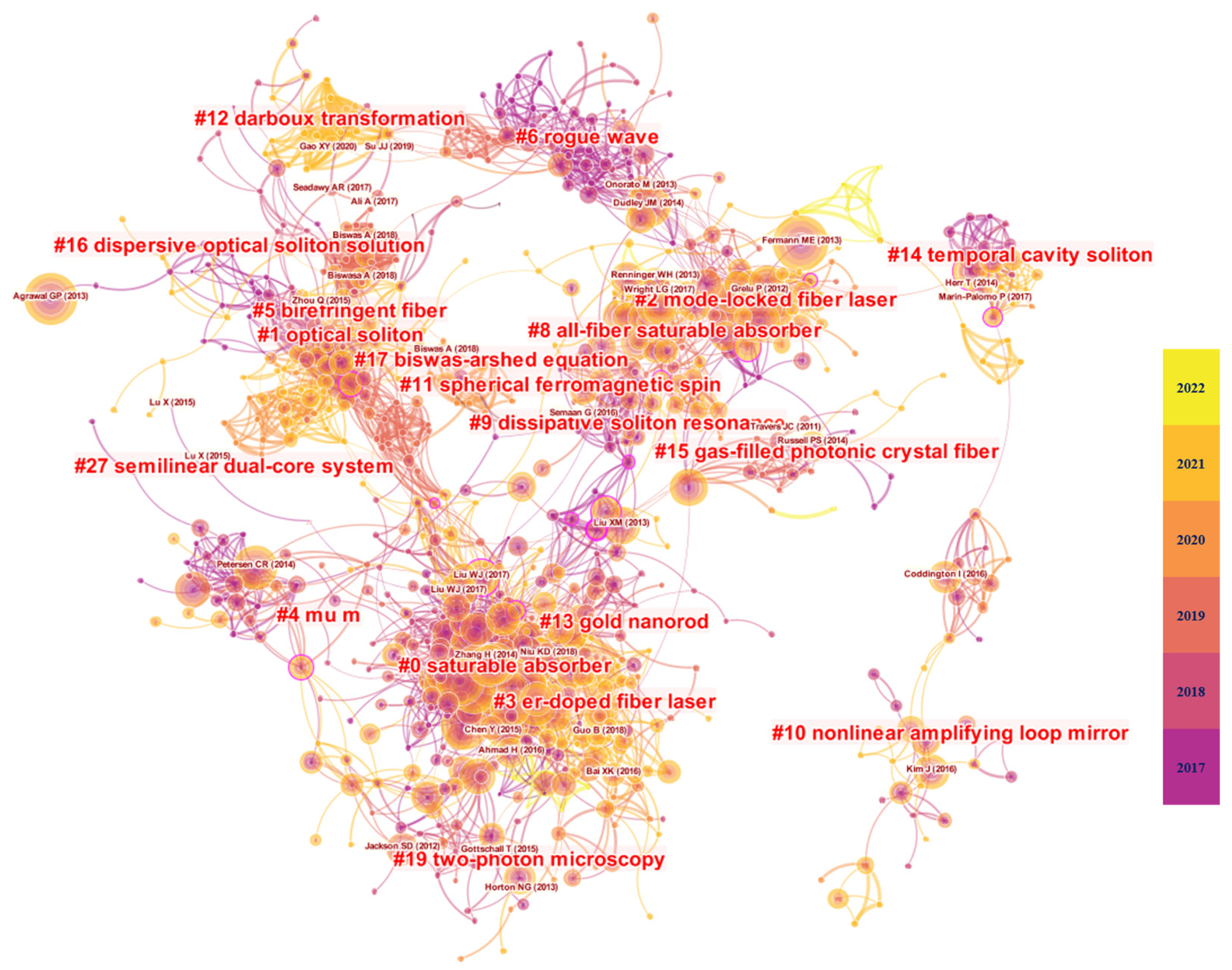
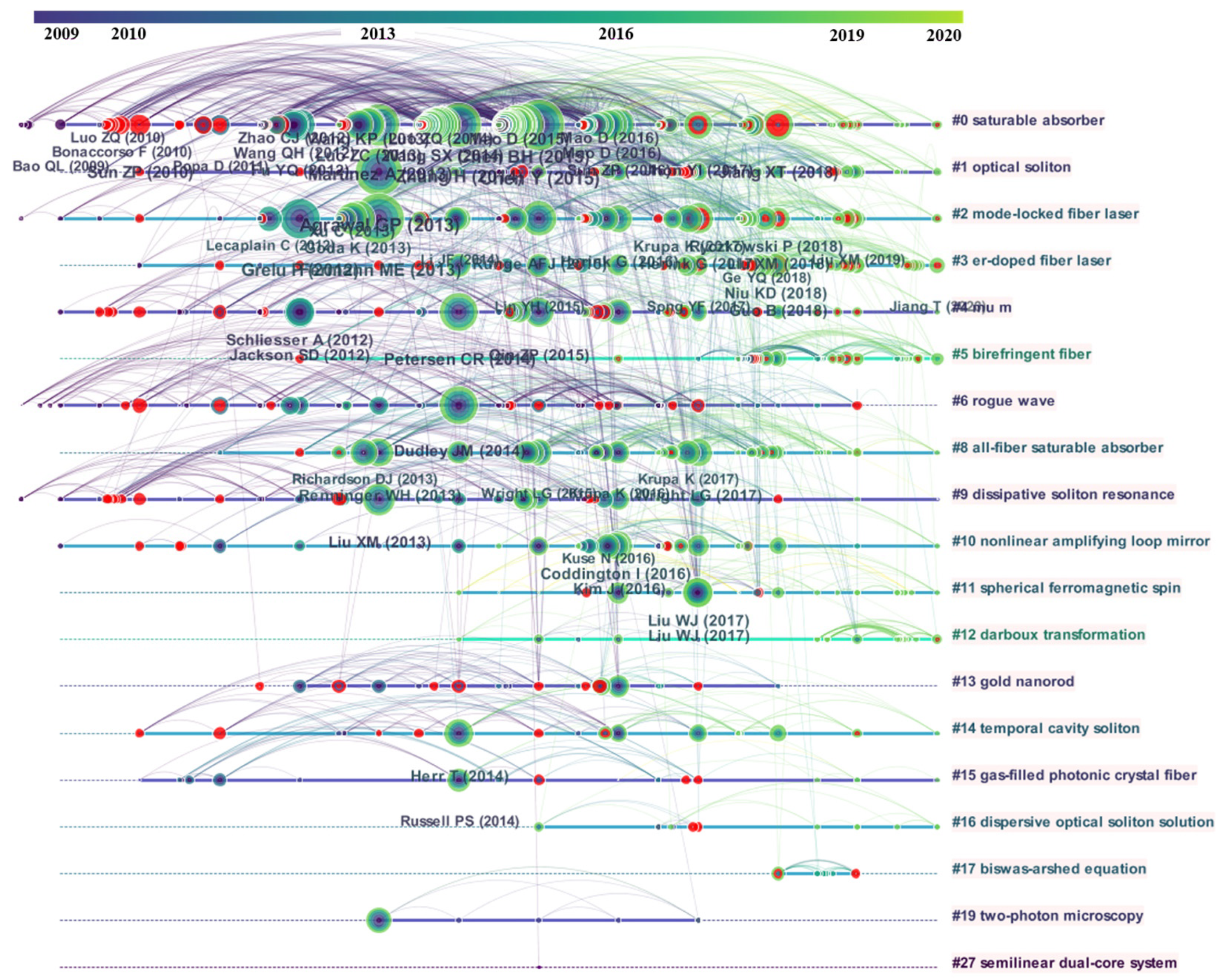

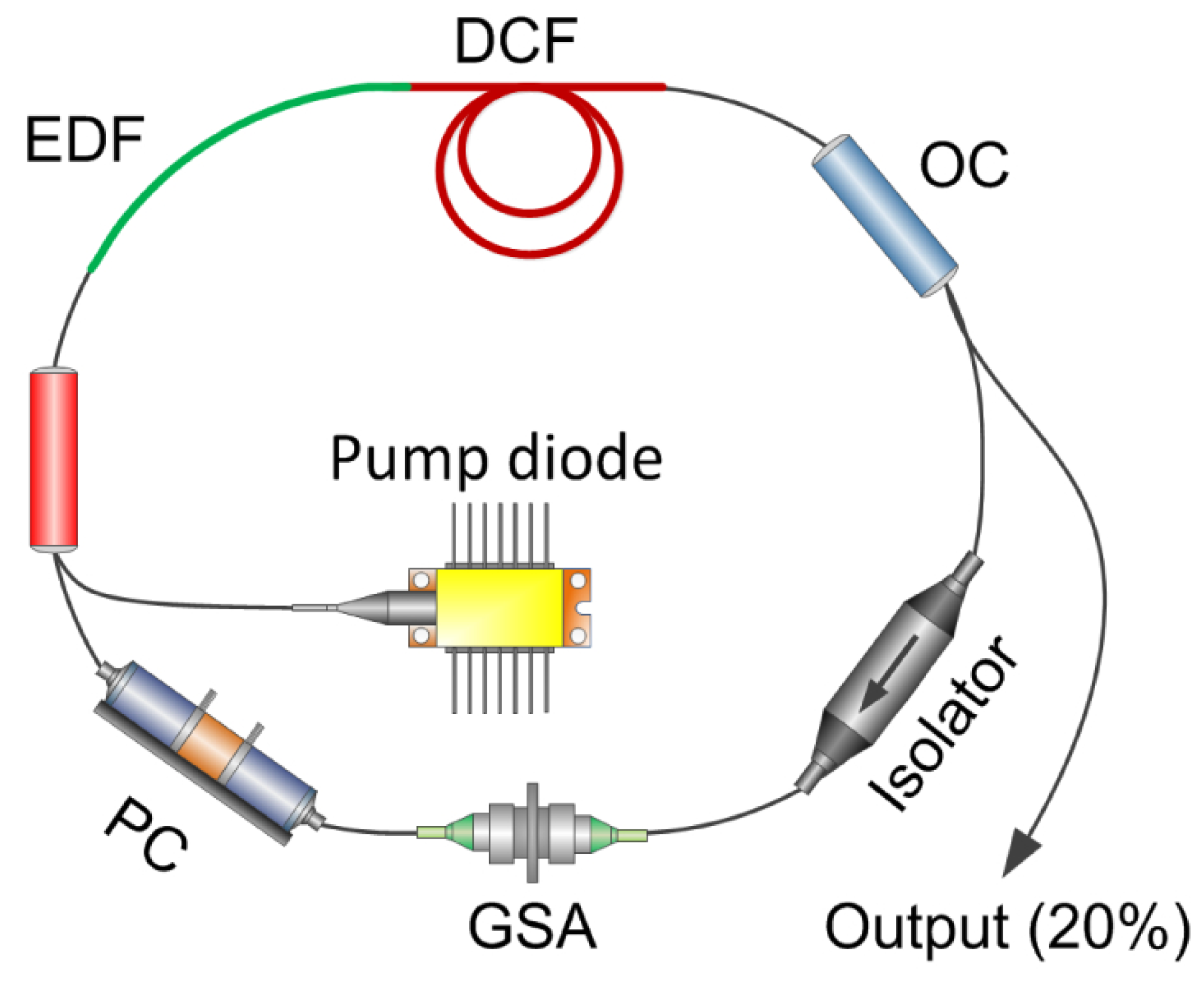

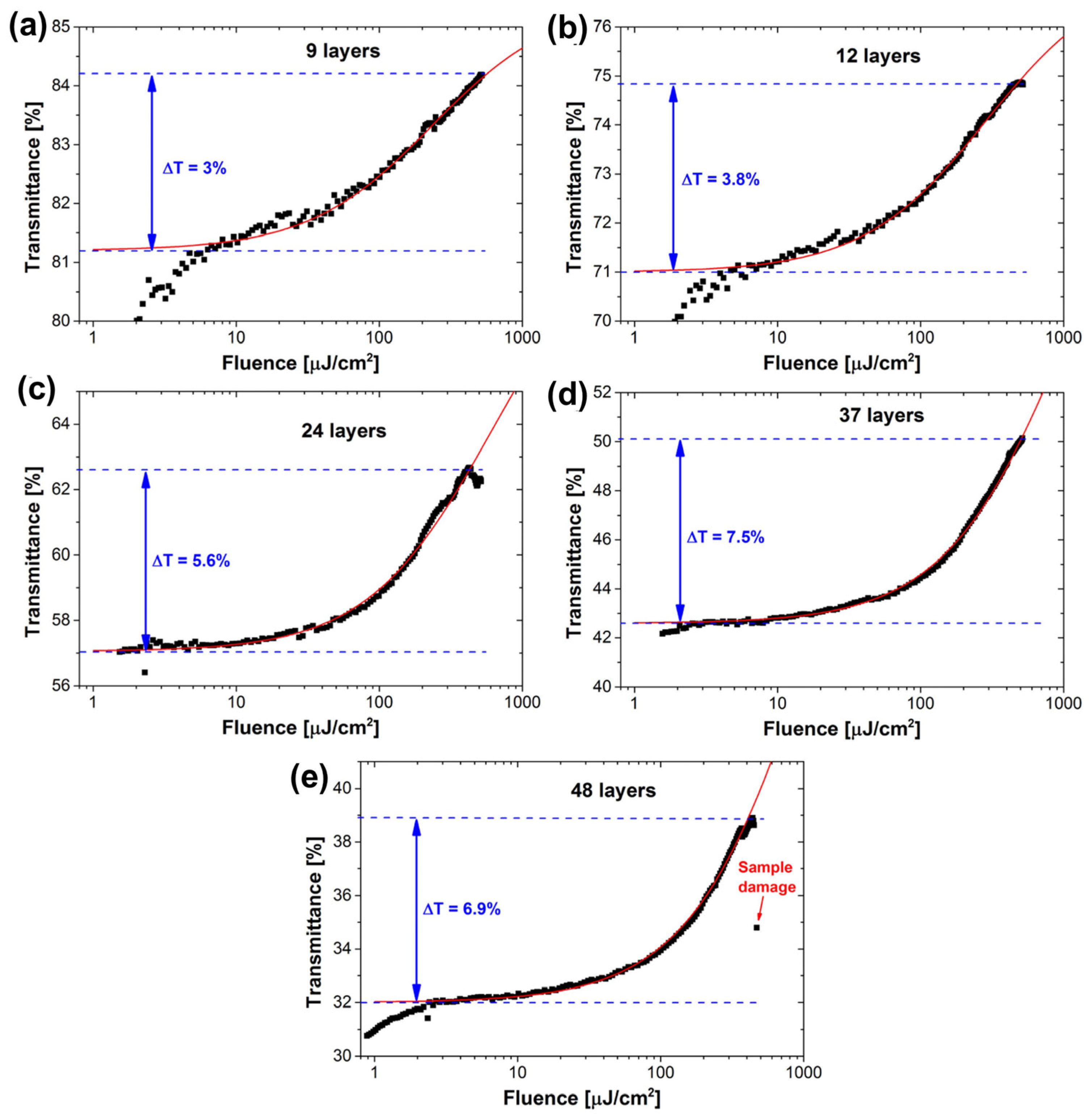
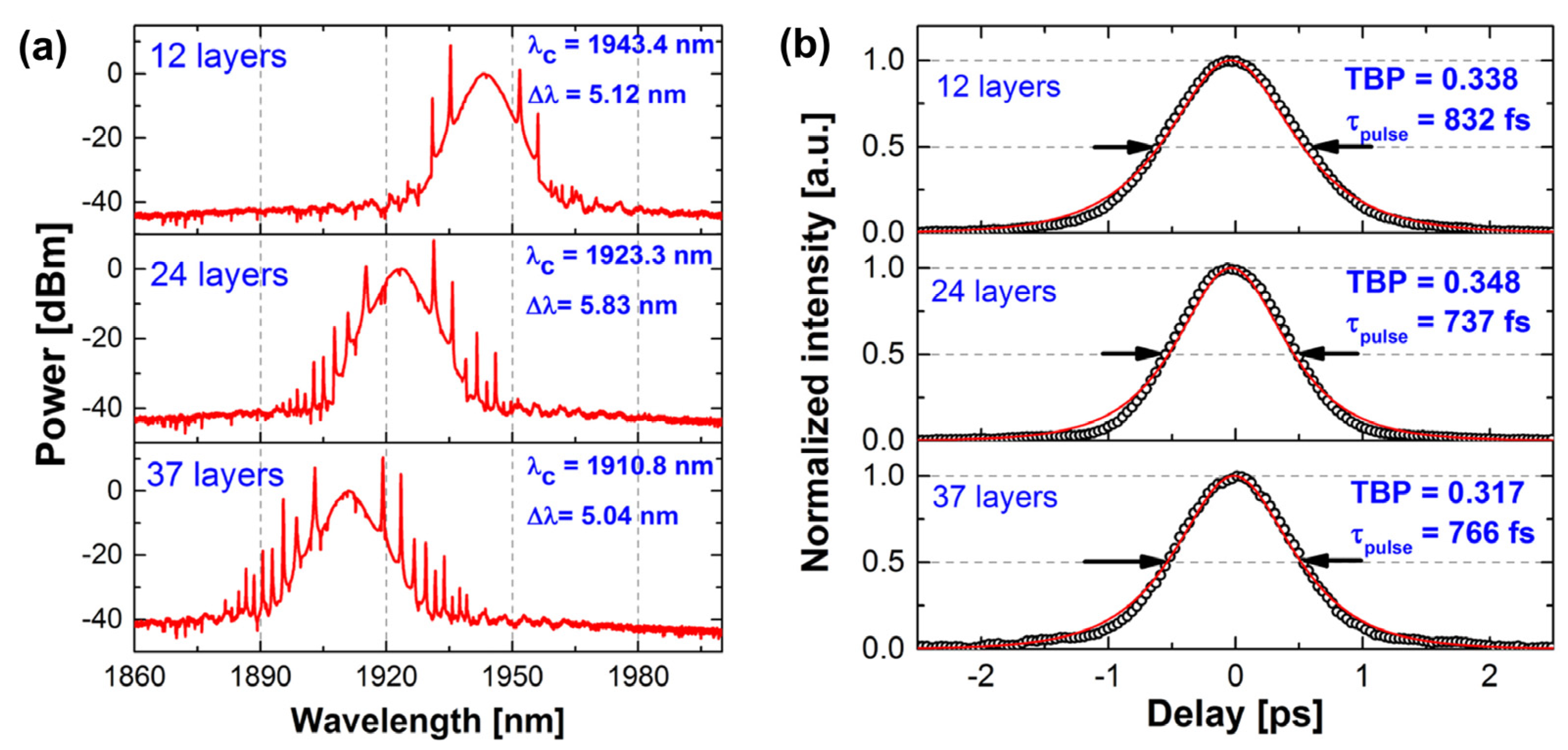
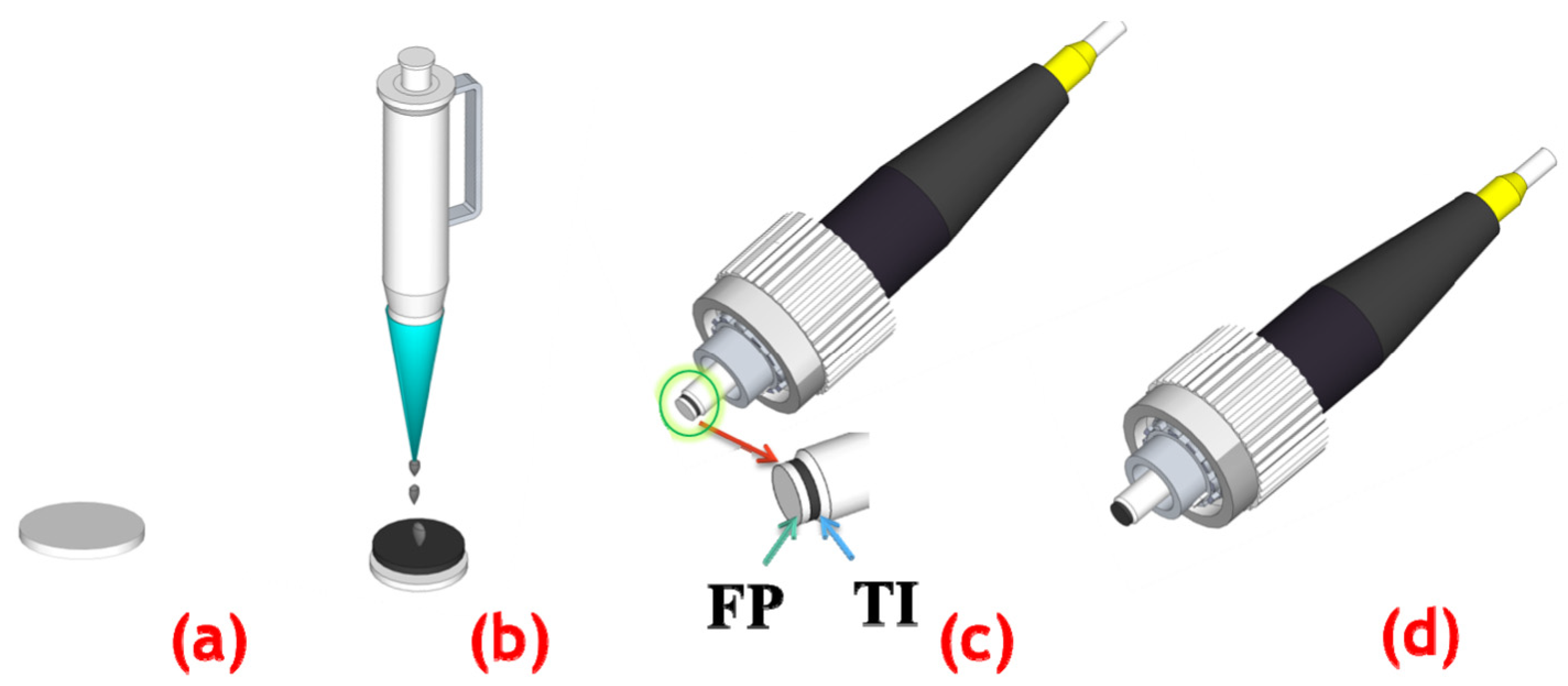
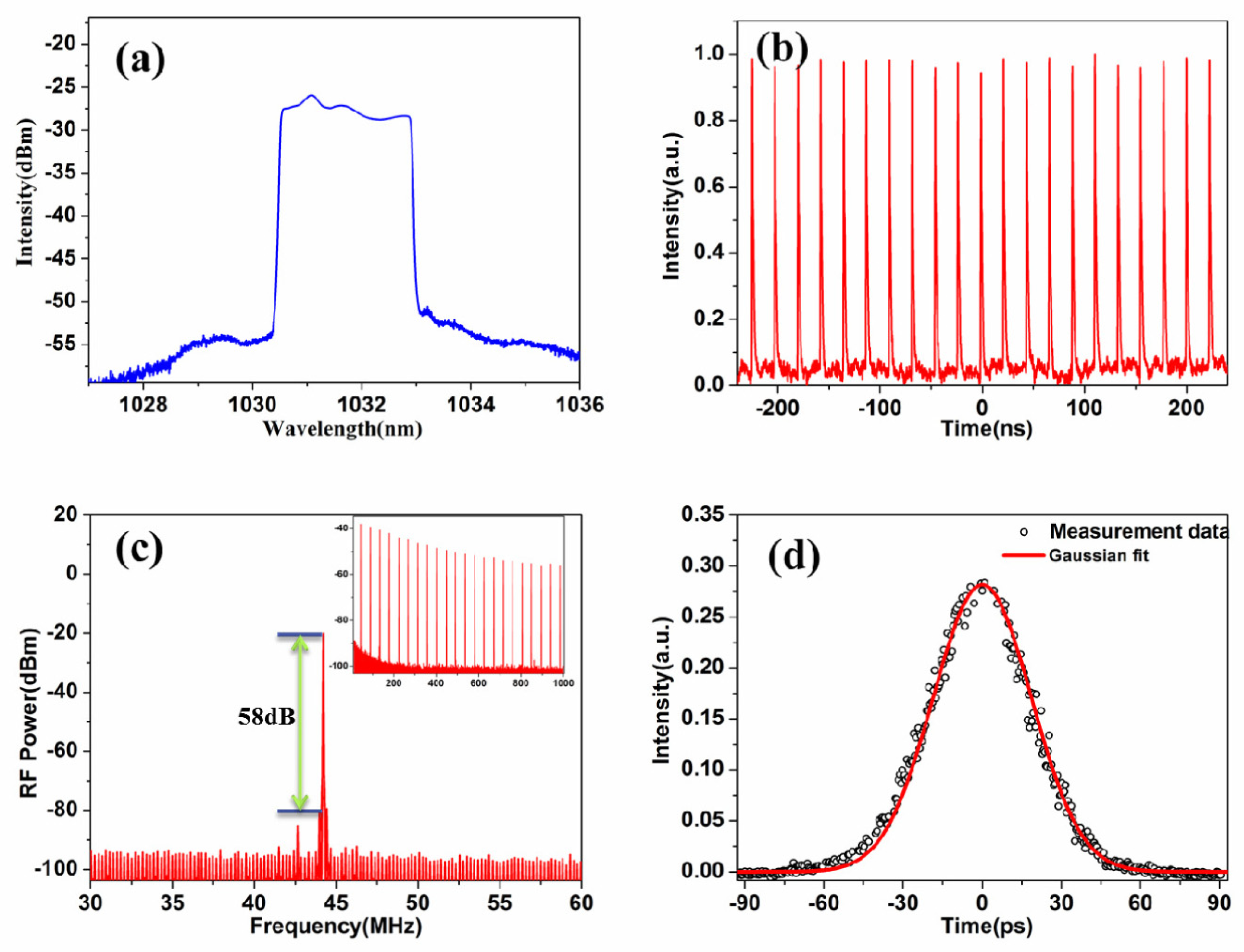
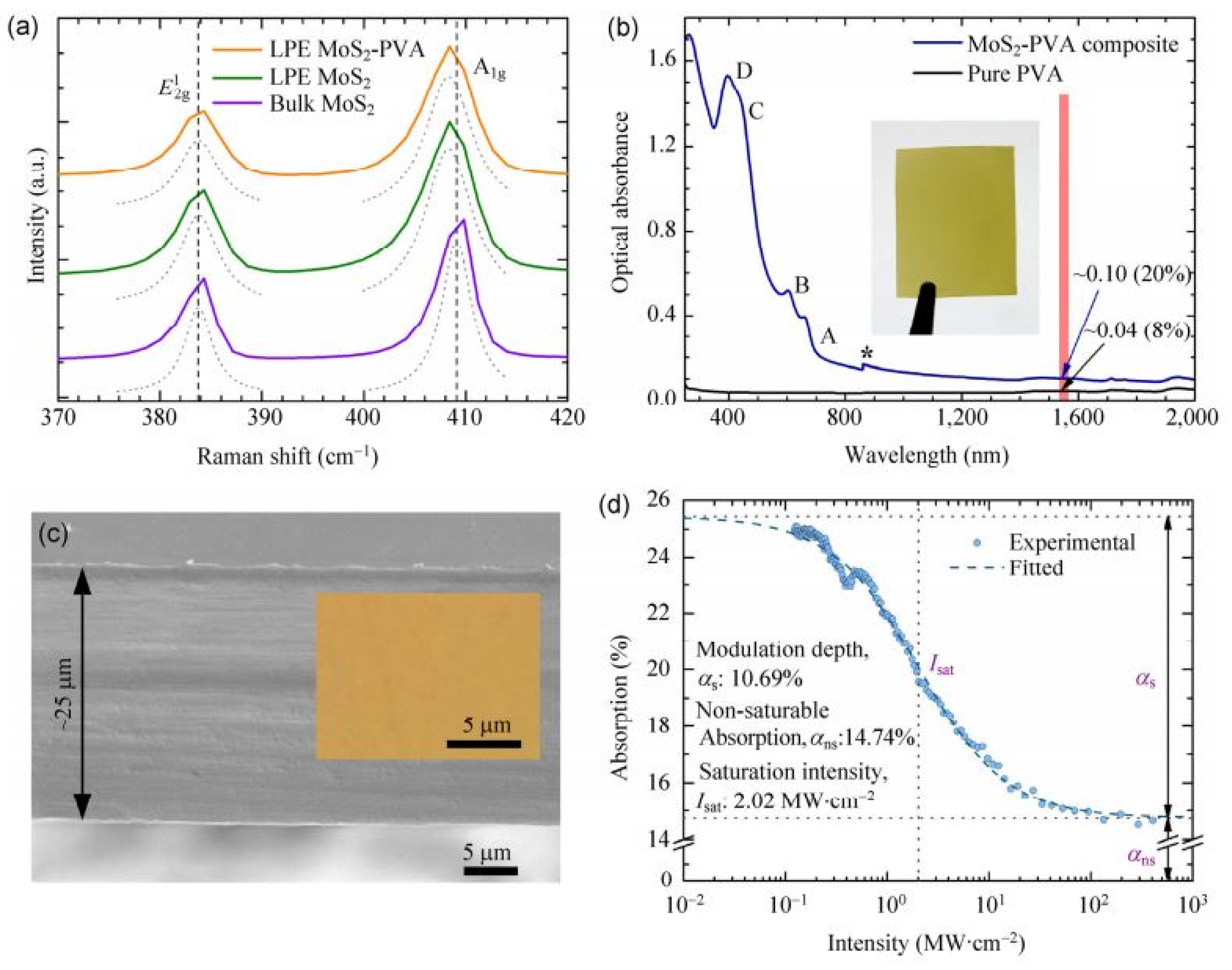
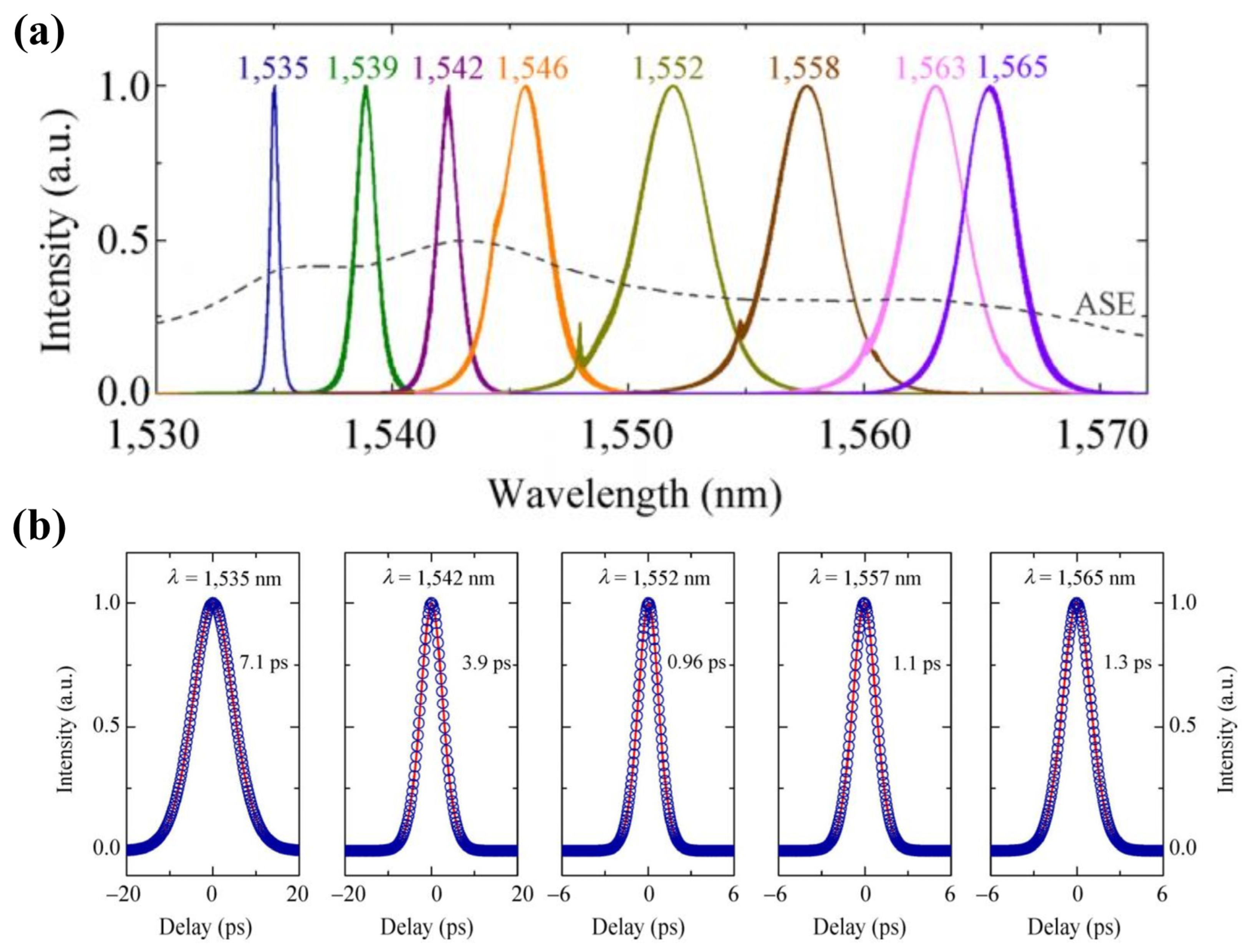
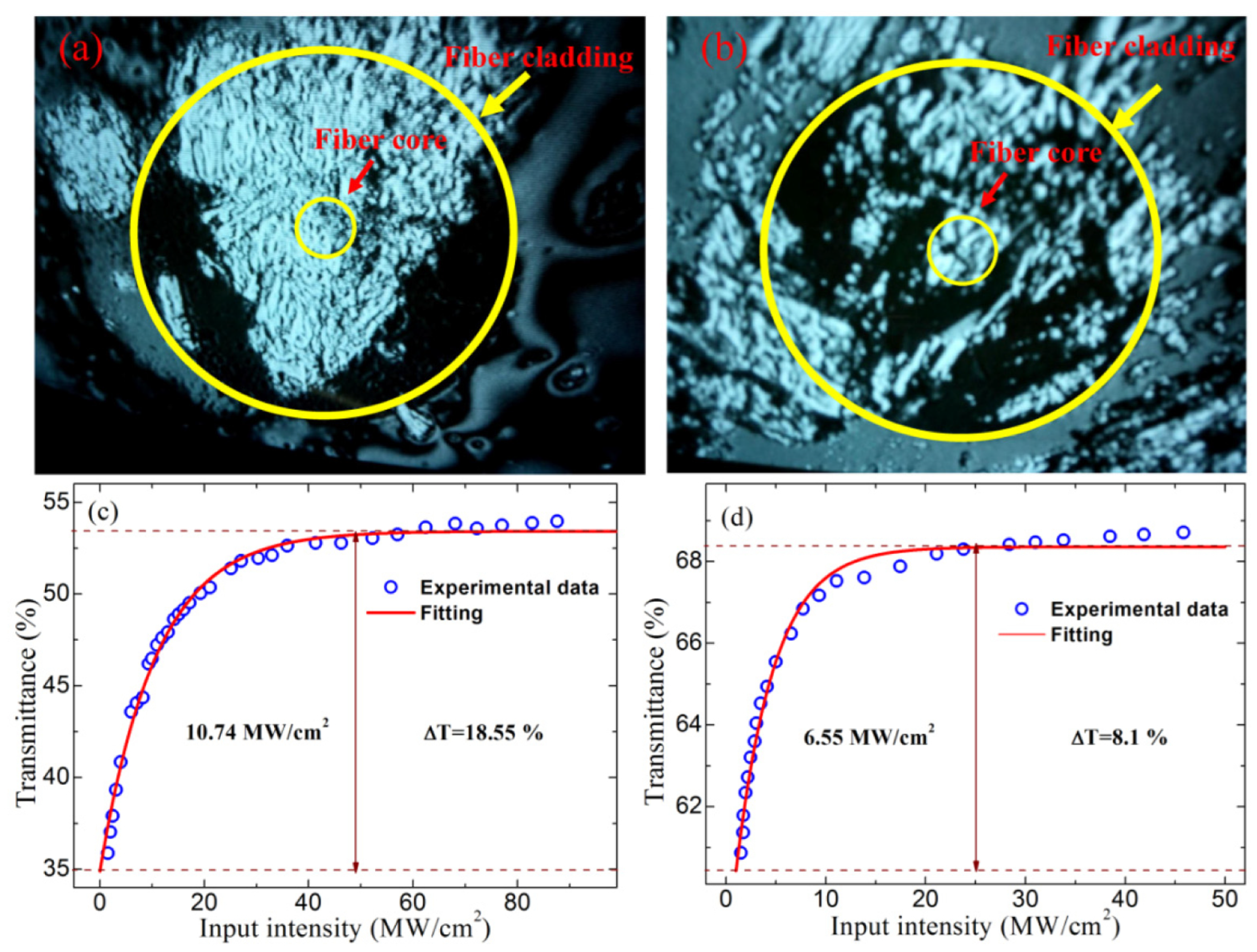
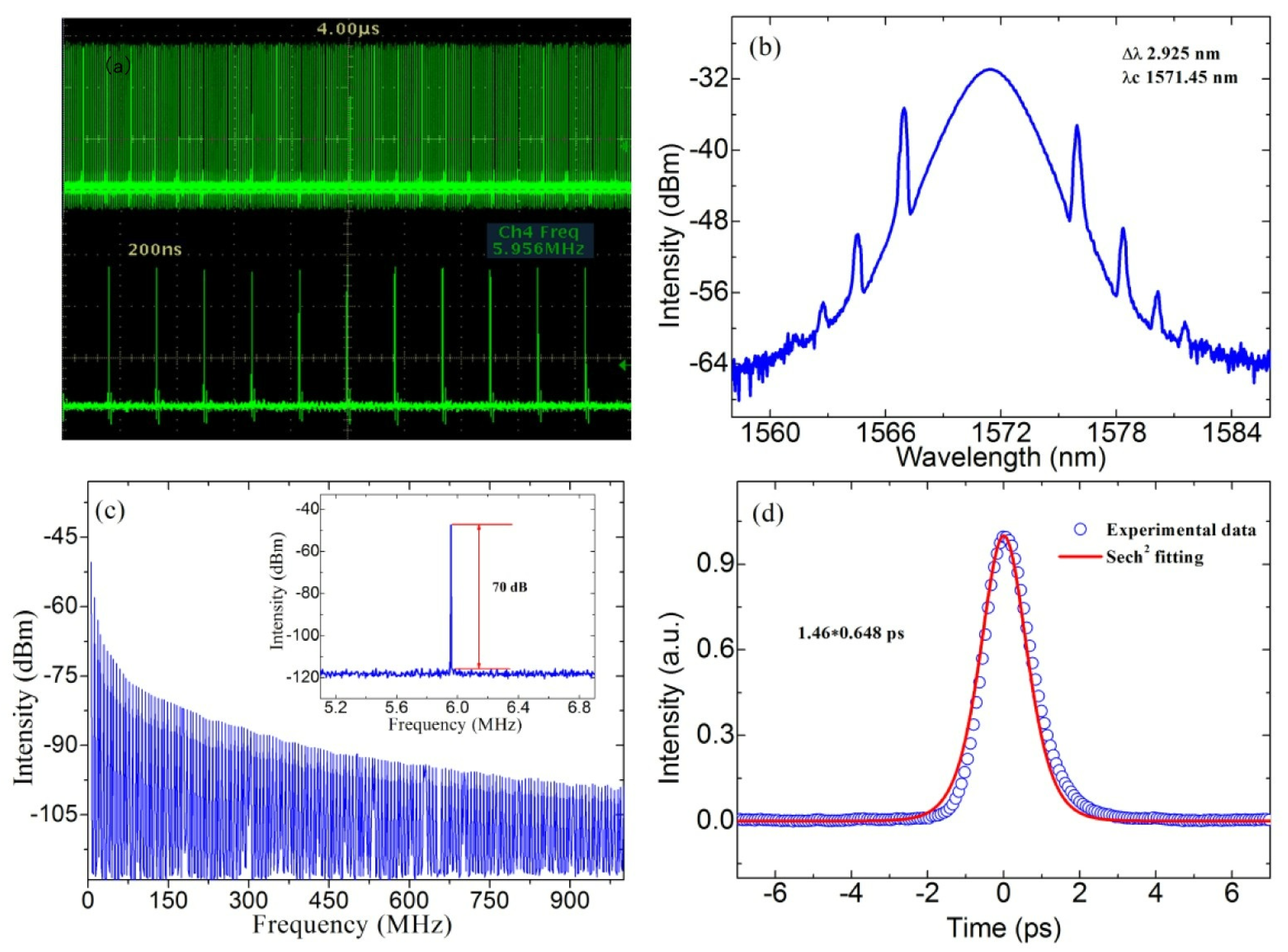
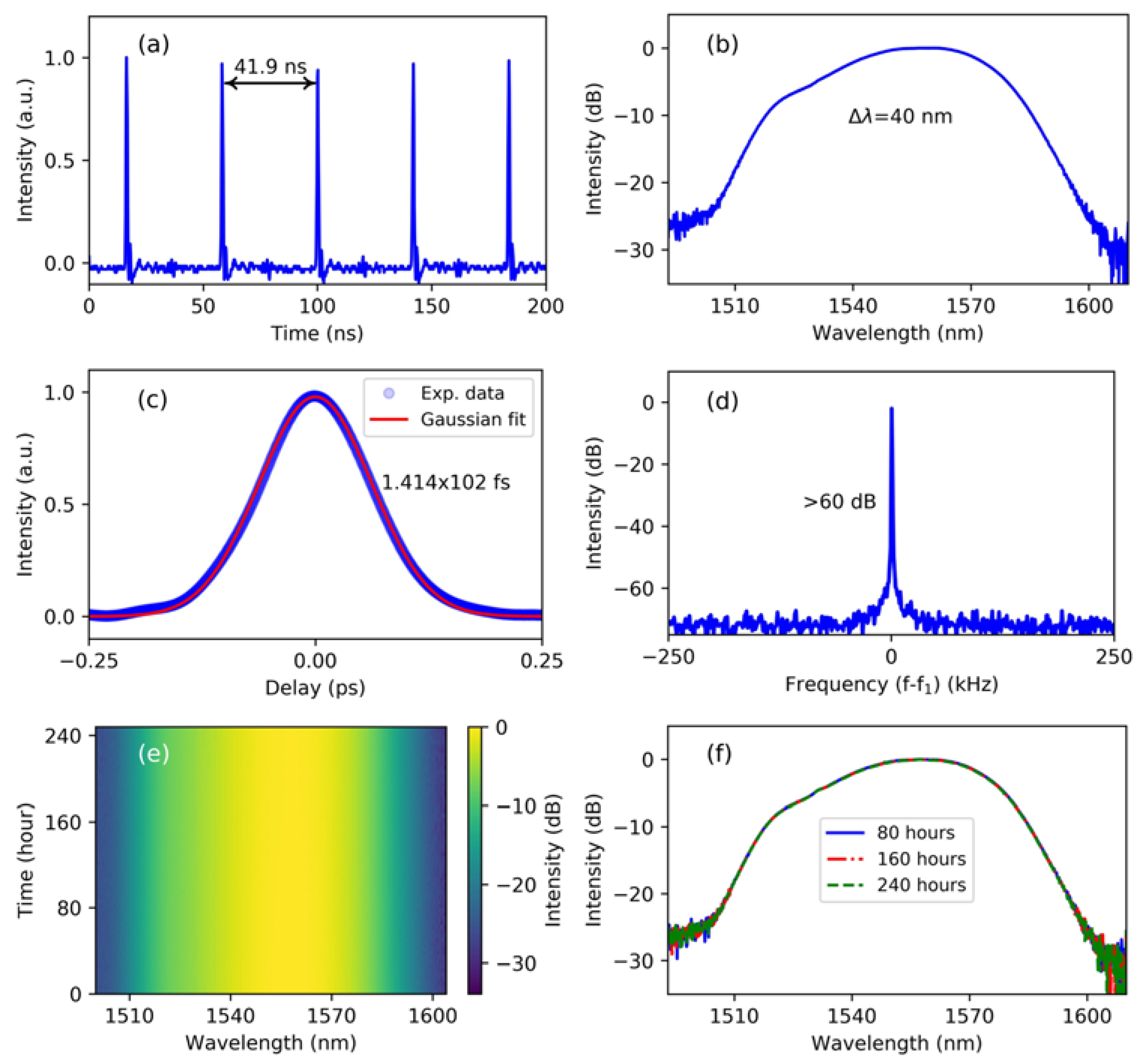
| Cluster ID | Size | Silhouette 1 | Label (LSI) 2 | Label (LLR) 3 | Label (MI) 4 | Average Year 5 |
|---|---|---|---|---|---|---|
| 0 | 199 | 0.878 | saturable absorber | saturable absorber (18,479.61, 1.0 × 10−4) | graded-index waveguide (2.62) | 2014 |
| 1 | 97 | 0.932 | optical soliton | optical soliton (12,202.86, 1.0 × 10−4) | graded-index waveguide (1.34) | 2016 |
| 2 | 68 | 0.952 | mode-locked fiber laser | mode-locked fiber laser (5738.23, 1.0 × 10−4) | graded-index waveguide (1.68) | 2015 |
| Materials | Gain Medium | Wavelength | Pulse Width | Repetition Rate | Pulse Energy | Ref. |
|---|---|---|---|---|---|---|
| Yb-doped | 1057.82 nm | 230 ps | 1.44 MHz | 0.6 nJ | [80] | |
| Yb-doped | 1064.47 nm | 960 ps | 1.11 MHz | —— | [88] | |
| Er-doped | 1547 nm | 600 fs | 15.11 MHz | 53 pJ | [90] | |
| Er-doped | 1560.8 nm | 286 fs | 18.55 MHz | 0.03 nJ | [91] | |
| Er-doped | 1562.4 nm | 320 fs | 17.34 Hz | 32 pJ | [92] | |
| Bi2Te3 | Er-doped | 1555.9 nm | 630 fs | 773.85 MHz | —— | [93] |
| Er-doped | 1558.5 nm | 2.49 ps | 2.04 GHz | —— | [94] | |
| Er-doped | 1561.48 nm | 0.78 ps | 24 MHz | 247.1 pJ | [95] | |
| Er-doped | 1558 nm | 1.21 ps | 1.21 MHz | —— | [78] | |
| Tm-Ho-doped | 1935 nm | 795 fs | 27.9 MHz | —— | [82] | |
| Ho-Pr-doped | 2830 nm | 6 ps | 10.4 Mhz | 8.6 nJ | [87] | |
| Yb-doped | 1031.7 nm | 46 ps | 44.6 MHz | 0.76 nJ | [81] | |
| Yb-doped | 1038.5 nm | 380 ps | 16 MHz | 1.06 nJ | [89] | |
| Er-doped | 1564.6 nm | 1.57 ps | 1.21 MHz | —— | [79] | |
| Bi2Se3 | Er-doped | 1557.5 nm | 660 fs | 12.14 MHz | 0.14 nJ | [96] |
| Er-doped | 1562.4 nm | 630 fs | 23.3 MHz | 15.6 pJ | [97] | |
| Er-doped | 1571 nm | 579 fs | 12.54 MHz | 127 pJ | [98] | |
| Er-doped | 1560.88 nm | 1.754 ps | 3.125 GHz | 4.5 pJ | [99] | |
| Tm-Ho-doped | 1912.12 nm | 853 fs | 18.37 MHz | —— | [83] | |
| Yb-doped | 1047.1 nm | 5.9 ps | 19.28 MHz | 0.21 nJ | [85] | |
| Er-doped | 1558.6 nm | 1.8 ps | 4.75 MHz | 0.105 nJ | [84] | |
| Er-doped | 1565 nm | 128 fs | 22.32 MHz | 44.8 pJ | [100] | |
| Er-doped | 1556 nm | 449 fs | 22.13 MHz | 39.6 pJ | [26] | |
| Sb2Te3 | Er-doped | 1568.6 nm | 195 fs | 33 MHz | 0.27 nJ | [27] |
| Er-doped | 1561 nm | 270 fs | 38.54 MHz | 29 pJ | [101] | |
| Er-doped | 1558 nm | 167 fs | 25.38 MHz | 0.21 nJ | [102] | |
| Tm-doped | 1930.07 nm | 1.24 ps | 14.52 MHz | 8.96 nJ | [103] | |
| Tm-Ho-doped | 1902.06 nm | 1.32 ps | 10.87 MHz | 283.34 pJ | [86] |
| Materials | Gain Medium | Wavelength | Pulse Width | Repetition Rate | Pulse Energy | Ref. |
|---|---|---|---|---|---|---|
| Yb-doped | 1054.3 nm | 800 ps | 6.58 MHz | —— | [110] | |
| Yb-doped | 1090 nm | 21.84 ps | 13.2 MHz | 1.48 nJ | [116] | |
| Er-doped | 1569.5 nm | 710 fs | 12.09 MHz | 0.147 nJ | [29] | |
| Er-doped | 1556.8 nm | 3 ps | 2.5 GHz | 2 pJ | [30] | |
| Er-doped | 1573.7 nm | 630 fs | 27.1 MHz | 0.141 nJ | [31] | |
| MoS2 | Er-doped | 1552 nm | 960 fs | 12.99 MHz | —— | [111] |
| Er-doped | 1561 nm | 246 fs | 101.4 MHz | 1.2 nJ | [117] | |
| Er-doped | 1567.7 nm | 1.4 ps | 5.78 MHz | —— | [118] | |
| Er-doped | 1563 nm | 2.17 ps | 0.987 MHz | —— | [119] | |
| Er-doped | 1535 nm | 1.07 ps | 13 MHz | —— | [120] | |
| Tm-doped | 1926 nm | 1.51 ps | 13.9 MHz | —— | [112] | |
| Tm-doped | 1915.5 nm | 1.25 ps | 18.72 MHz | —— | [121] | |
| Yb-doped | 1063 nm | 630 ps | 5.57 MHz | 13.6 nJ | [114] | |
| Yb-doped | 1030.3 nm | 2.5 ns | 2.84 MHz | 2.82 nJ | [122] | |
| Yb-doped | 1029.1 nm | 59 ps | 19.03 MHz | —— | [123] | |
| Er-doped | 1572 nm | 595 fs | —— | —— | [113] | |
| Er-doped | 1565 nm | 21.1 ps | 8.05 MHz | 2.2 nJ | [114] | |
| Er-doped | 1560.1 nm | 325 fs | 30.91 MHz | —— | [123] | |
| WS2 | Er-doped | 1560 nm | 288 fs | 41.4 MHz | 0.04 pJ | [124] |
| Er-doped | 1563.8 nm | 808 fs | 19.57 MHz | 0.1336 nJ | [125] | |
| Er-doped | 1565 nm | 332 fs | 31.11 MHz | 14 pJ | [126] | |
| Er-doped | 1560 nm | 605 fs | 8.83 MHz | 1.14 nJ | [127] | |
| Er-doped | 1540 nm | 67 fs | 135 MHz | —— | [128] | |
| Er-doped | 1560 nm | 395 fs | 19.57 MHz | 76.6 pJ | [129] | |
| Tm-doped | 1941 nm | 1.3 ps | 34.8 MHz | 172 pJ | [115] | |
| Er-doped | 1555.6 nm | 737 fs | 3.27 GHz | 7 pJ | [130] | |
| MoSe2 | Er-doped | 1560 nm | 580 fs | 8.8 MHz | 91.3 pJ | [131] |
| Er-doped | 1552 nm | 207 fs | 64.56 MHz | —— | [132] | |
| Tm-doped | 1943.35 nm | 980 fs | 23.53 MHz | 0.39 nJ | [133] | |
| Er-doped | 1557.6 nm | 1.25 ps | 5.25 MHz | —— | [134] | |
| Wse2 | Er-doped | 1557.4 nm | 163.5 fs | 63.13 MHz | 451 pJ | [135] |
| Er-doped | 1555.2 nm | 698.5 fs | 23.95 MHz | 0.21 nJ | [136] | |
| Tm-doped | 1863.96 nm | 1.16 fs | 11.36 MHz | 2.9 nJ | [137] | |
| Yb-doped | 1031 nm | 282 ps | 3.76 MHz | —— | [138] | |
| SnS2 | Er-doped | 1561 nm | 1.63 ps | 4.40 MHz | —— | [138] |
| Er-doped | 1562.01 nm | 623 fs | 29.33 MHz | 41 pJ | [139] | |
| Tm-doped | 1910 nm | —— | 1.99 MHz | —— | [138] | |
| Er-doped | 1558.6 nm | 1.6 ps | 5.48 MHz | 73 pJ | [140] | |
| Er-doped | 1565 nm | 2.549 ps | 1.896 MHz | 37 pJ | [141] | |
| ReS2 | Er-doped | 1564 nm | 1.25 ps | 3.43 MHz | —— | [142] |
| Er-doped | 1550 nm | 220 fs | 16.26 MHz | —— | [143] | |
| Tm-doped | 1970.65 nm | 893 fs | 26.1 MHz | —— | [144] |
| Materials | Gain Medium | Wavelength | Pulse Width | Repetition Rate | Pulse Energy | Ref. |
|---|---|---|---|---|---|---|
| Yb-doped | 1085.58 nm | 7.54 ps | 13.5 MHz | 5.93 nJ | [151] | |
| Yb-doped | 1030.6 nm | 400 ps | 46.3 MHz | 0.70 nJ | [154] | |
| Er-doped | 1571.45 nm | 648 fs | 5.96 MHz | 2.3 nJ | [32] | |
| Er-doped | 1560.5 nm | 272 fs | 28.2 MHz | —— | [149] | |
| Er-doped | 1555 nm | 102 fs | 23.9 MHz | 0.08 nJ | [152] | |
| Er-doped | 1556.5 nm | 940 fs | 9.46 MHz | —— | [155] | |
| Er-doped | 1558.14 nm | 2.18 ps | 15.59 MHz | —— | [156] | |
| Er-doped | 1569.24 nm | 280 fs | 60.5 MHz | —— | [157] | |
| Er-doped | 1559.5 nm | 670 fs | 8.77 MHz | —— | [158] | |
| BP | Er-doped | 1560.7 nm | 570 fs | 6.88 MHz | 0.74 nJ | [159] |
| Er-doped | 1558.8 nm | 805 fs | 3.82 MHz | —— | [160] | |
| Er-doped | 1558.7 nm | 786 fs | 14.7 MHz | 0.11 nJ | [161] | |
| Er-doped | 1562.8 nm | 291 fs | 10.36 MHz | —— | [162] | |
| Er-doped | 1555 nm | 687 fs | 37.8 MHz | —— | [163] | |
| Er-doped | 1562 nm | 635 fs | 12.5 MHz | —— | [164] | |
| Tm-doped | 1910 nm | 739 fs | 36.8 MHz | 40.7 pJ | [150] | |
| Tm-Ho-doped | 1898 nm | 1.58 ps | 19.2 MHz | 440 pJ | [165] | |
| Ho-doped | 2094 nm | 1.3 ps | 290 MHz | 0.39 nJ | [166] | |
| Er-doped | 2783 nm | 42 ps | 24.27 MHz | 25.5 nJ | [153] | |
| Er-doped | 2771.5 nm | —— | 27.4 MHz | 0.23 nJ | [167] | |
| Er-doped | 3489 nm | —— | 28.91 MHz | 1.38 nJ | [168] |
Publisher’s Note: MDPI stays neutral with regard to jurisdictional claims in published maps and institutional affiliations. |
© 2022 by the authors. Licensee MDPI, Basel, Switzerland. This article is an open access article distributed under the terms and conditions of the Creative Commons Attribution (CC BY) license (https://creativecommons.org/licenses/by/4.0/).
Share and Cite
Zhou, W.; Pang, X.; Zhang, H.; Yu, Q.; Liu, F.; Wang, W.; Zhao, Y.; Lu, Y.; Yang, Z. Frontier and Hot Topics of Pulsed Fiber Lasers via CiteSpace Scientometric Analysis: Passively Mode-Locked Fiber Lasers with Real Saturable Absorbers Based on Two-Dimensional Materials. Materials 2022, 15, 6761. https://doi.org/10.3390/ma15196761
Zhou W, Pang X, Zhang H, Yu Q, Liu F, Wang W, Zhao Y, Lu Y, Yang Z. Frontier and Hot Topics of Pulsed Fiber Lasers via CiteSpace Scientometric Analysis: Passively Mode-Locked Fiber Lasers with Real Saturable Absorbers Based on Two-Dimensional Materials. Materials. 2022; 15(19):6761. https://doi.org/10.3390/ma15196761
Chicago/Turabian StyleZhou, Wen, Xiuyang Pang, Hanke Zhang, Qiang Yu, Fangqi Liu, Wenyue Wang, Yikun Zhao, Yan Lu, and Zixin Yang. 2022. "Frontier and Hot Topics of Pulsed Fiber Lasers via CiteSpace Scientometric Analysis: Passively Mode-Locked Fiber Lasers with Real Saturable Absorbers Based on Two-Dimensional Materials" Materials 15, no. 19: 6761. https://doi.org/10.3390/ma15196761
APA StyleZhou, W., Pang, X., Zhang, H., Yu, Q., Liu, F., Wang, W., Zhao, Y., Lu, Y., & Yang, Z. (2022). Frontier and Hot Topics of Pulsed Fiber Lasers via CiteSpace Scientometric Analysis: Passively Mode-Locked Fiber Lasers with Real Saturable Absorbers Based on Two-Dimensional Materials. Materials, 15(19), 6761. https://doi.org/10.3390/ma15196761






